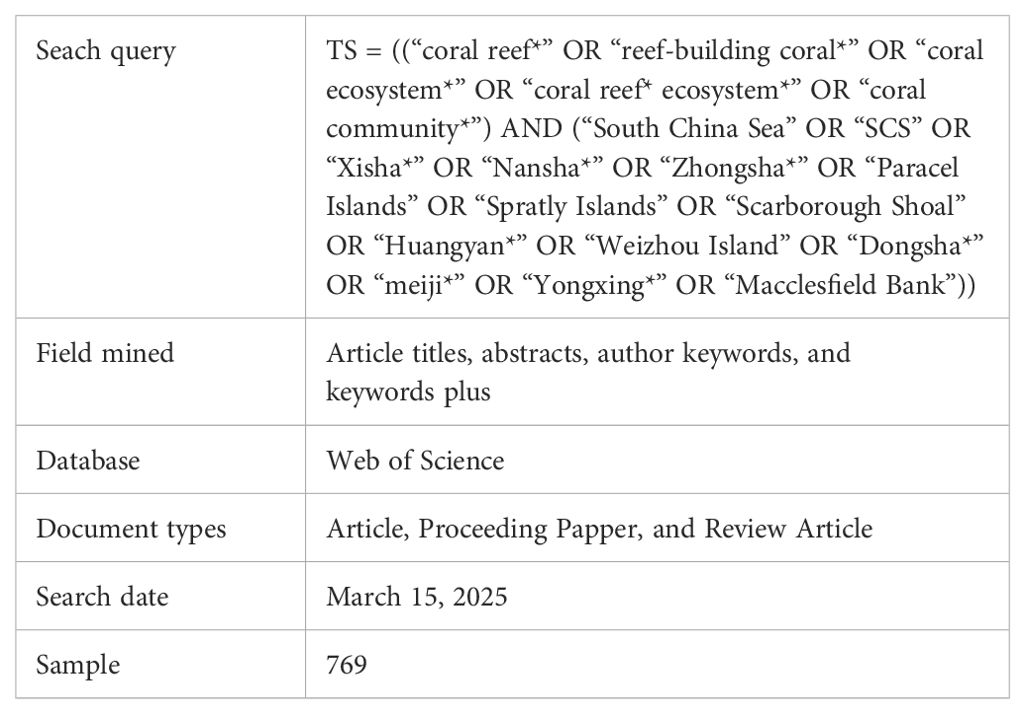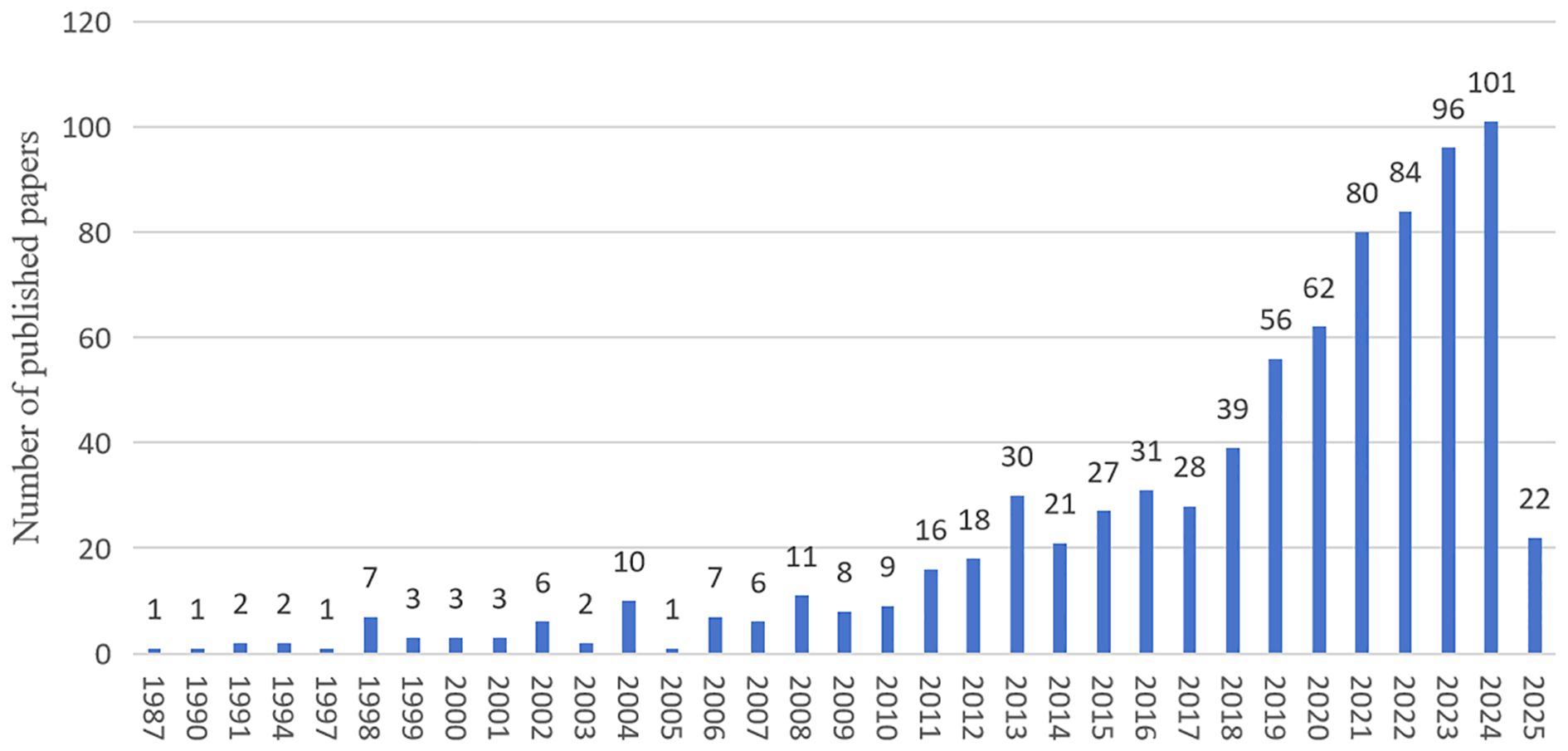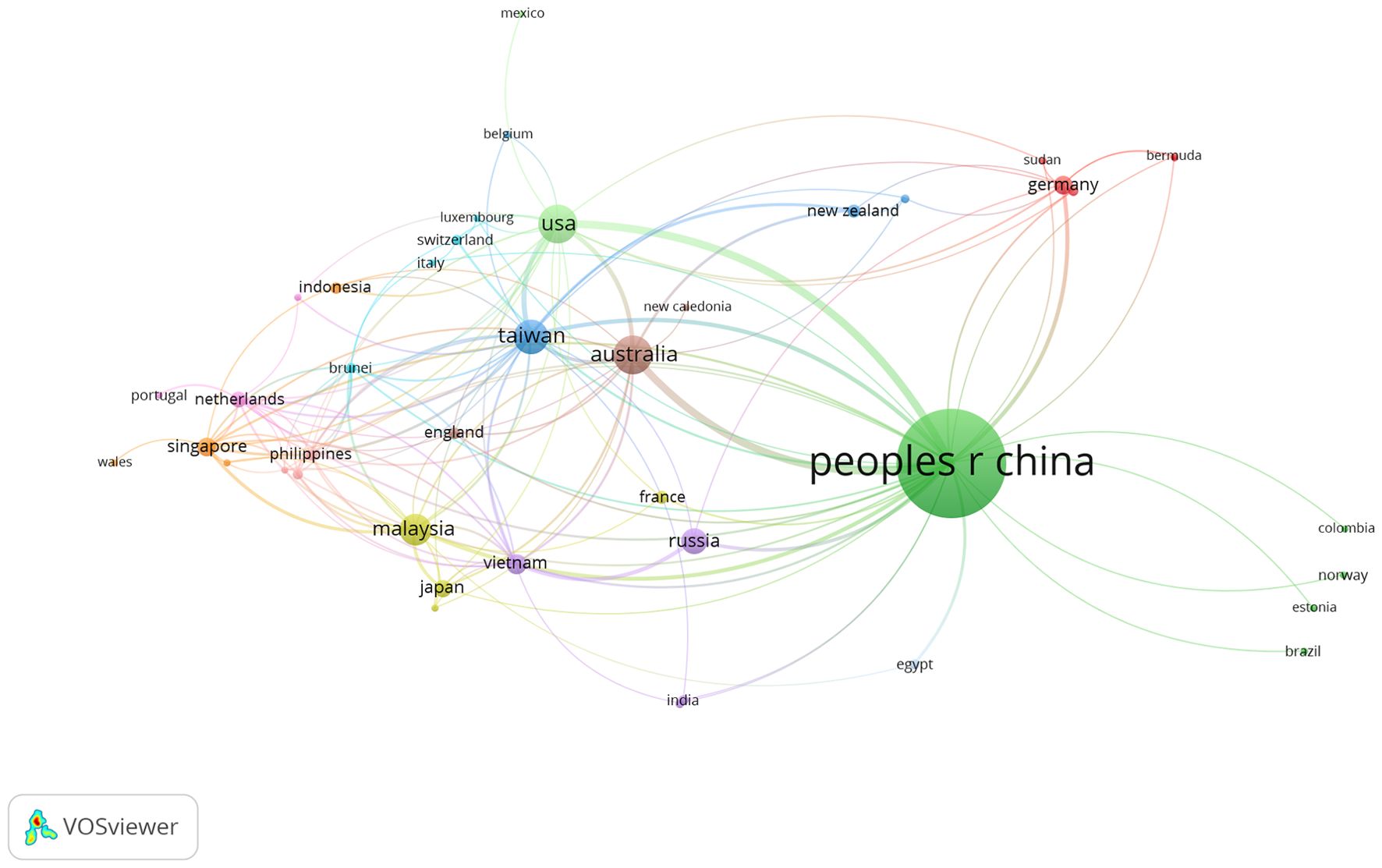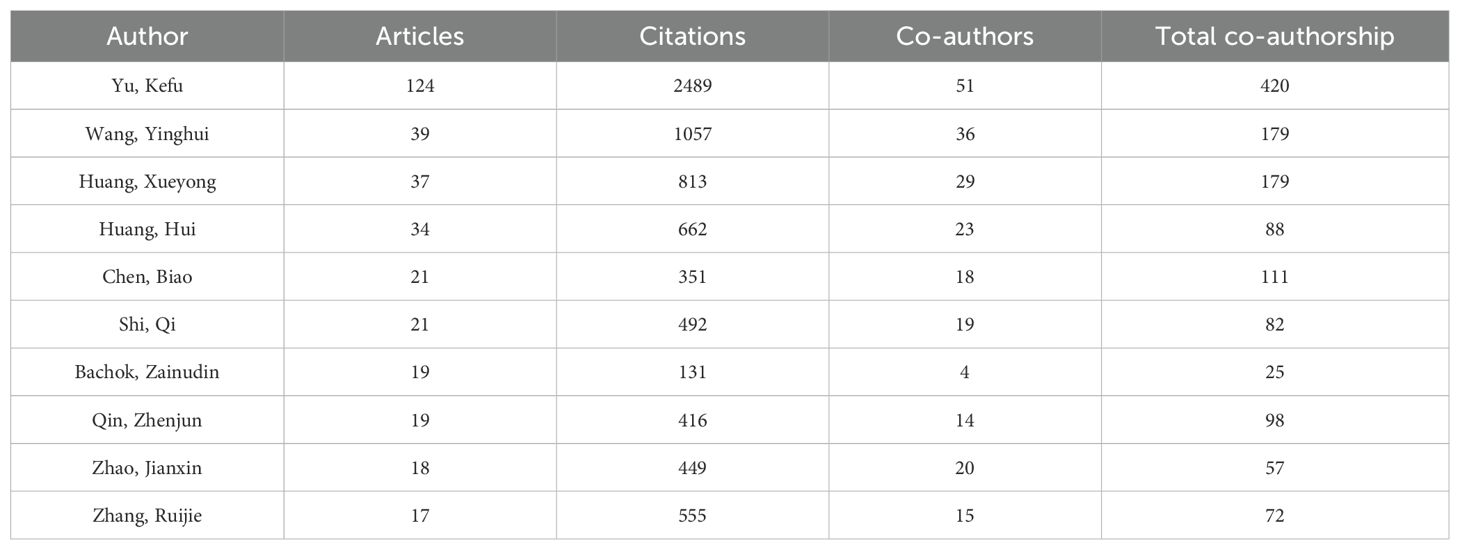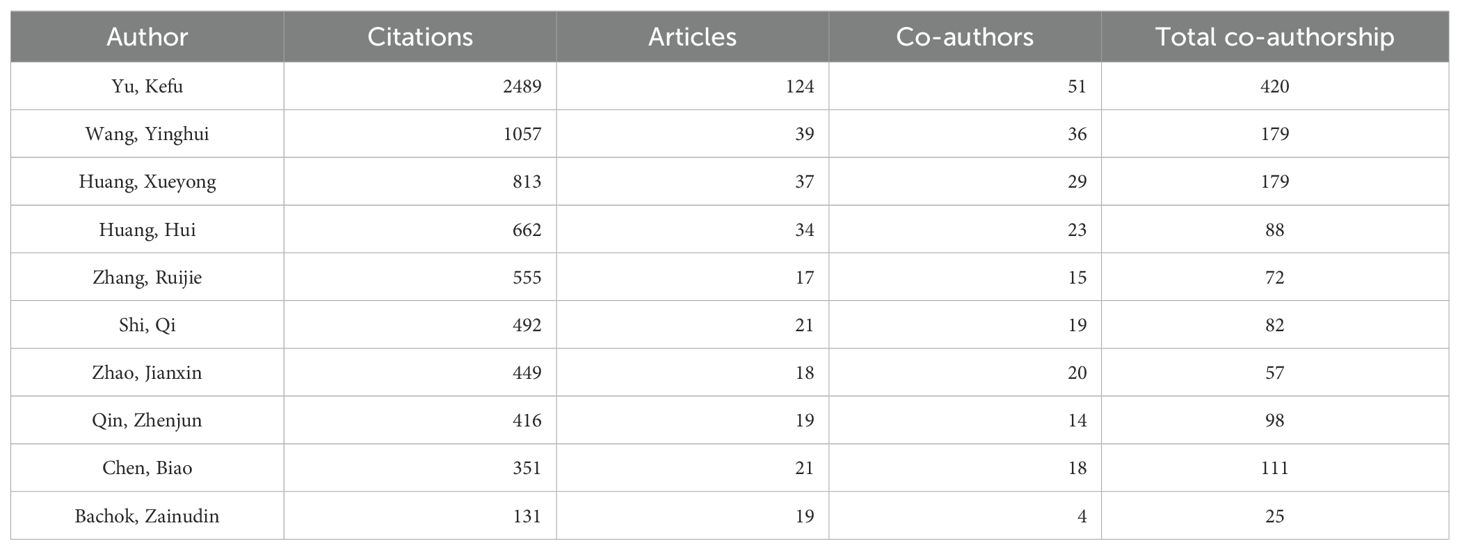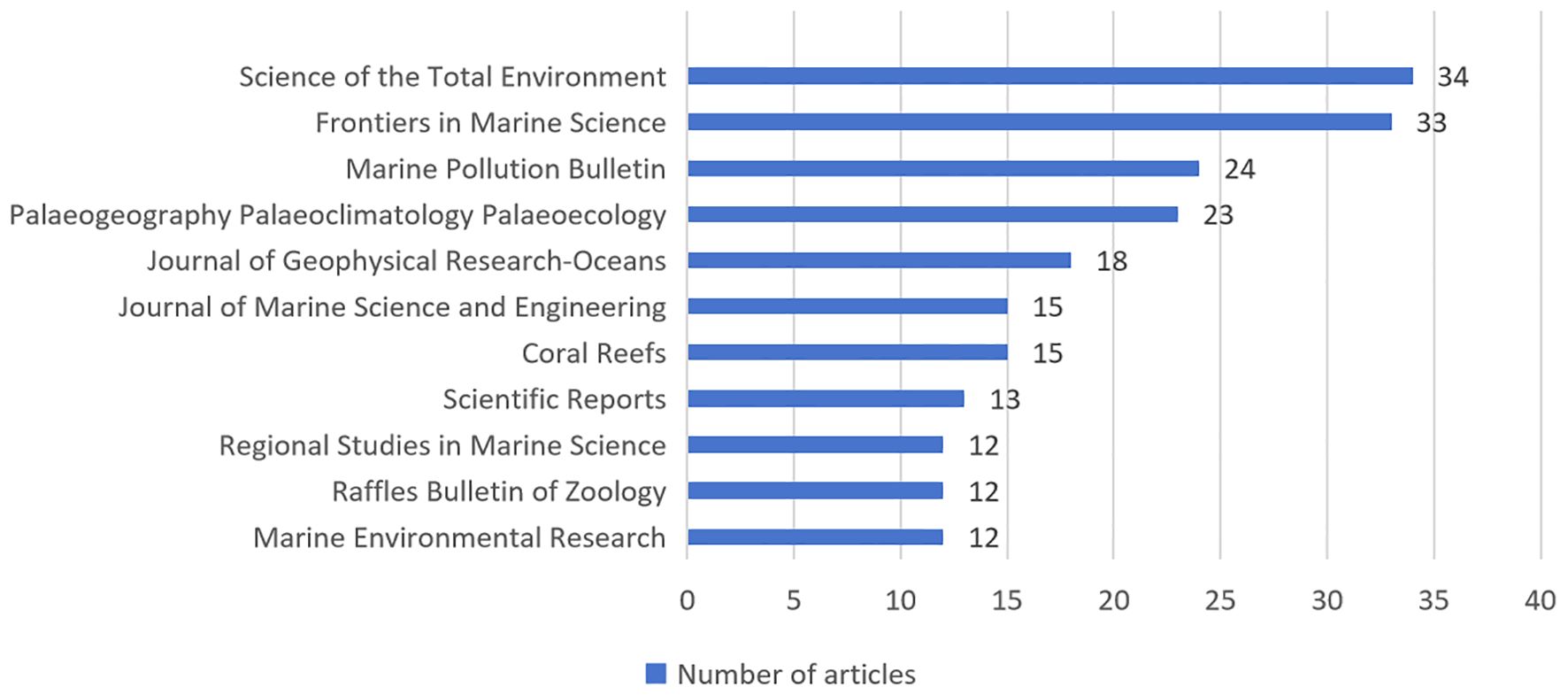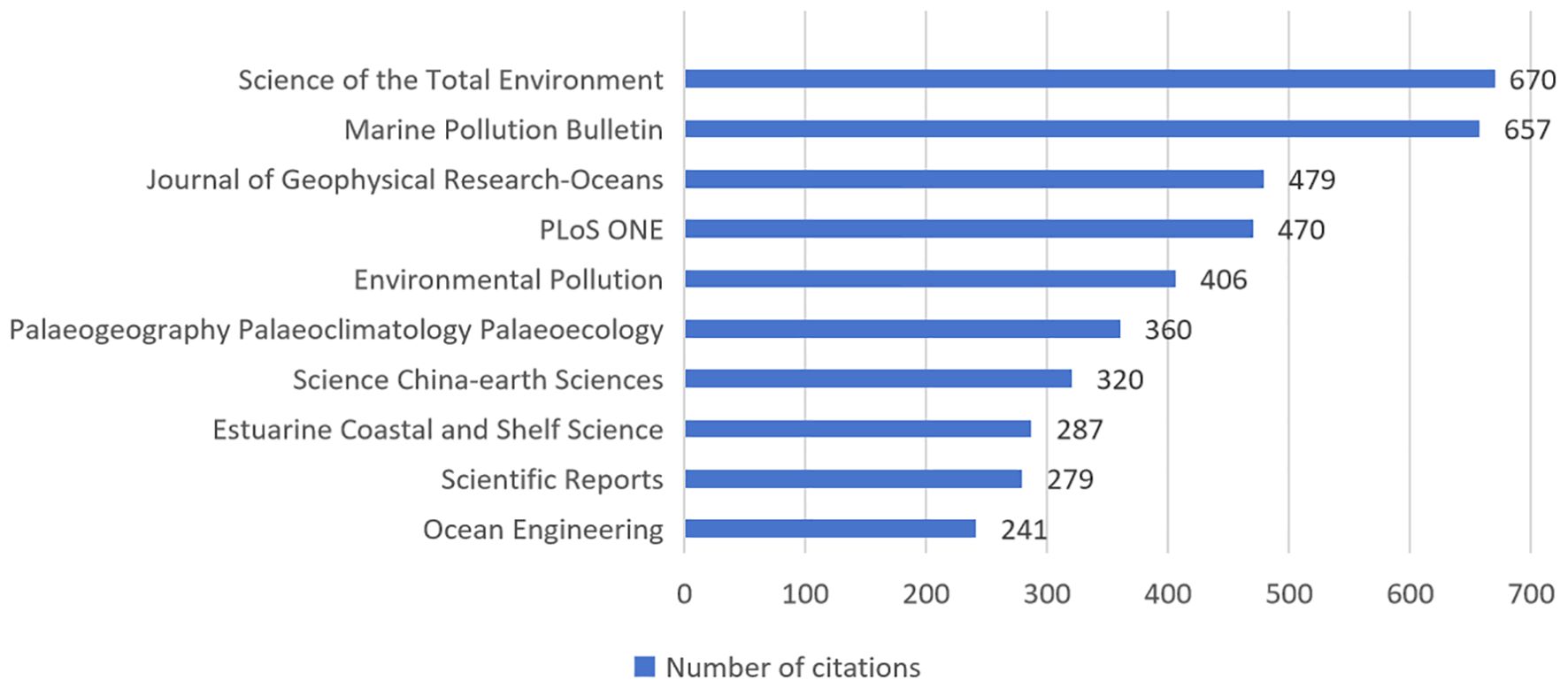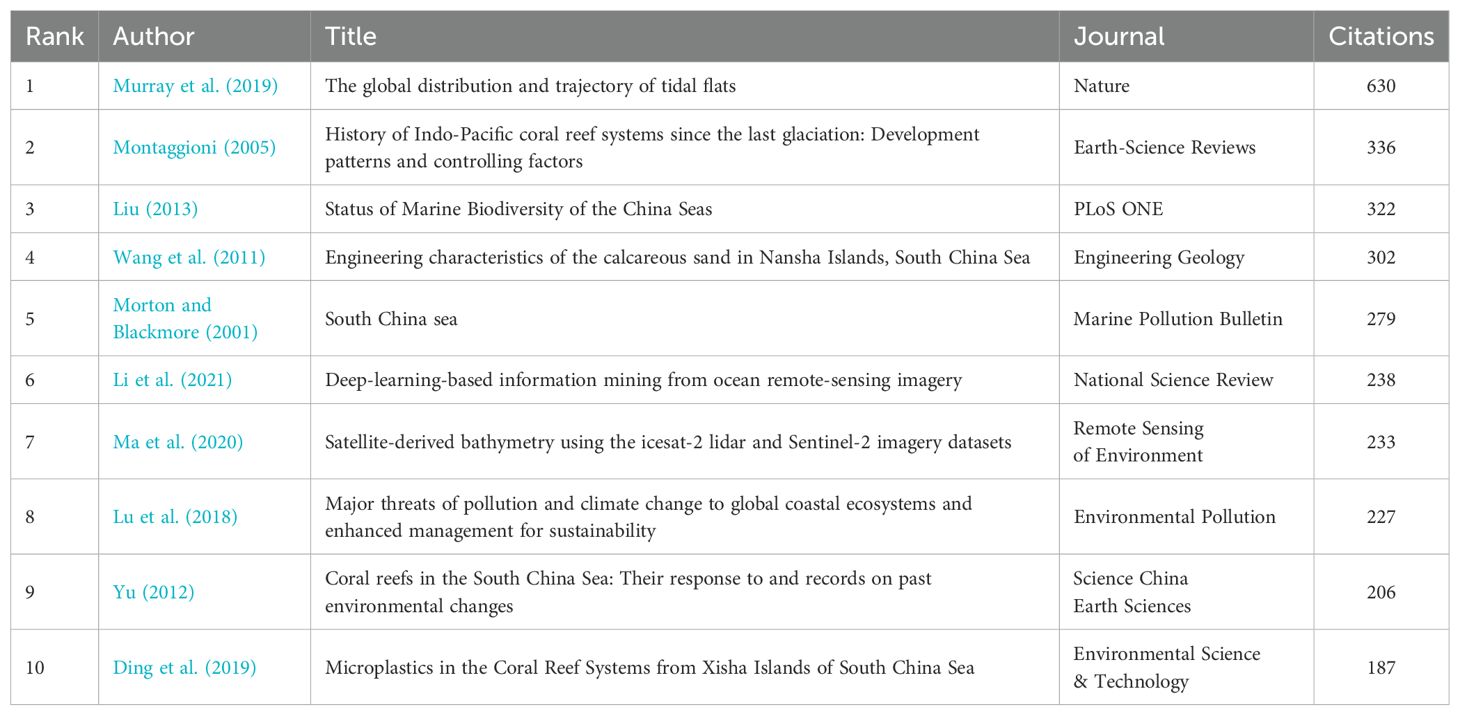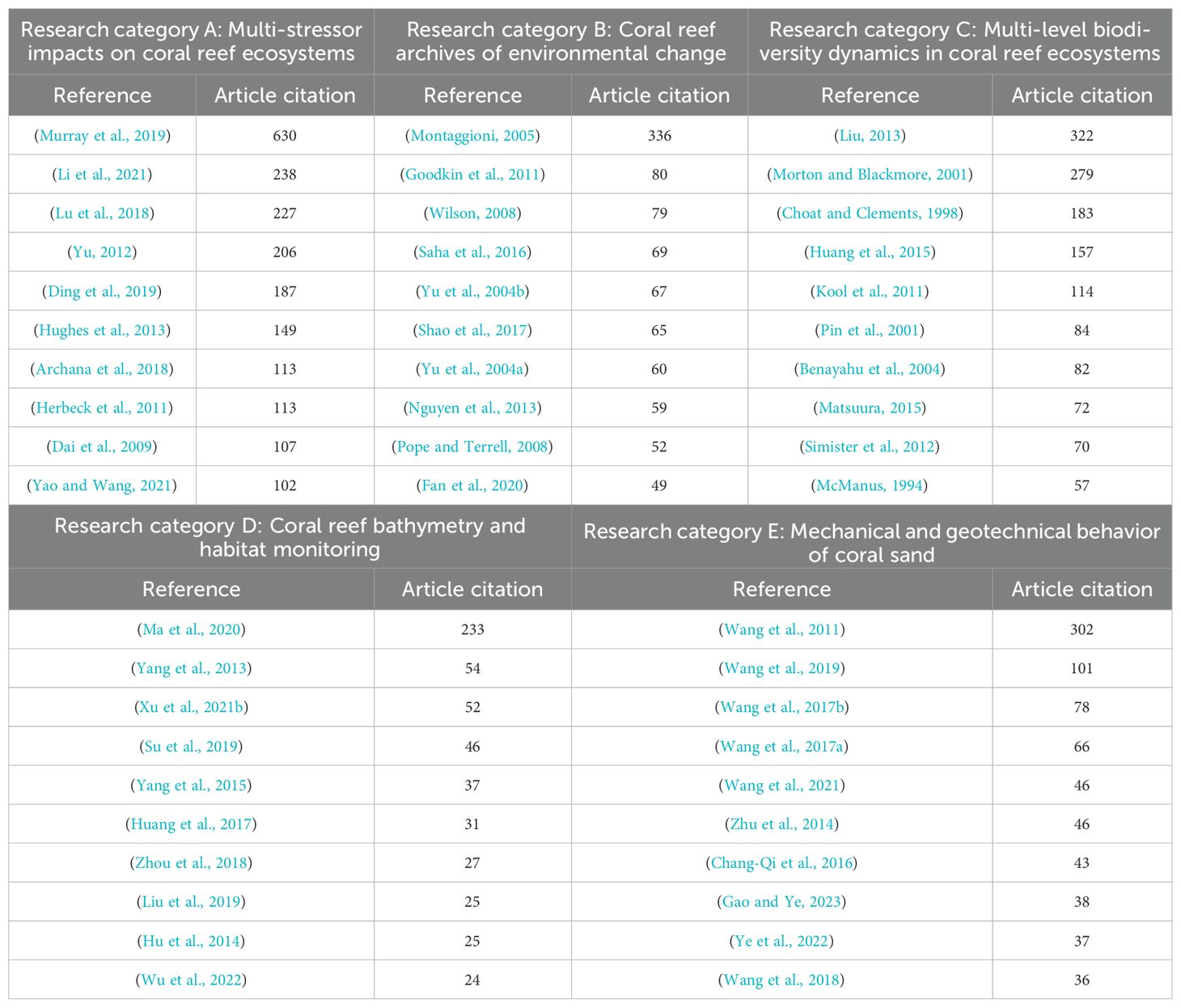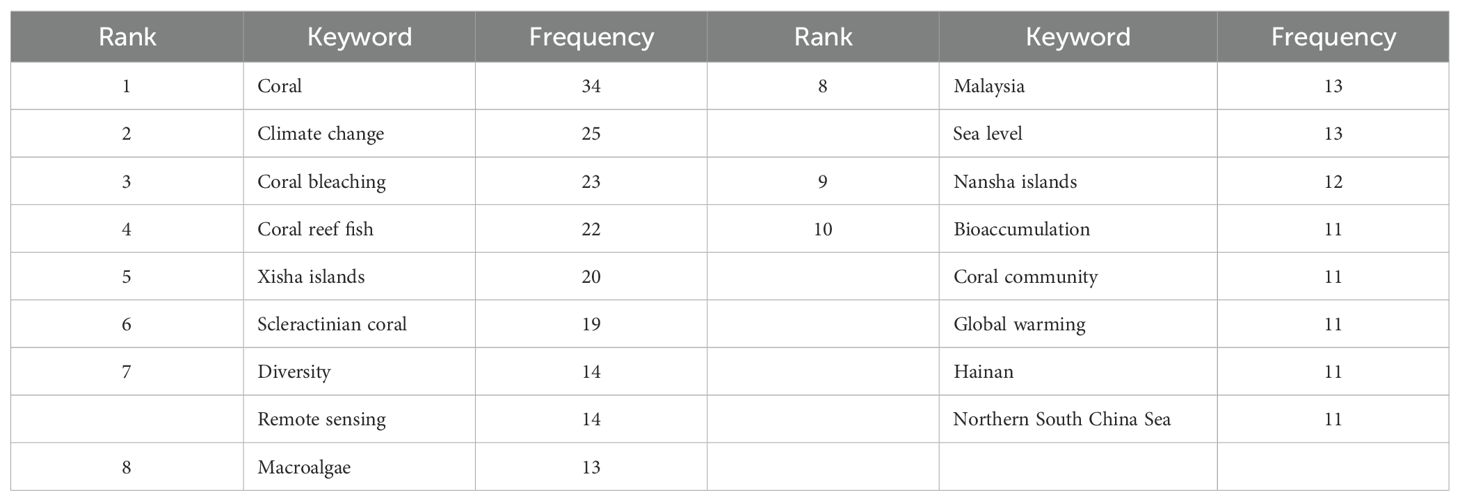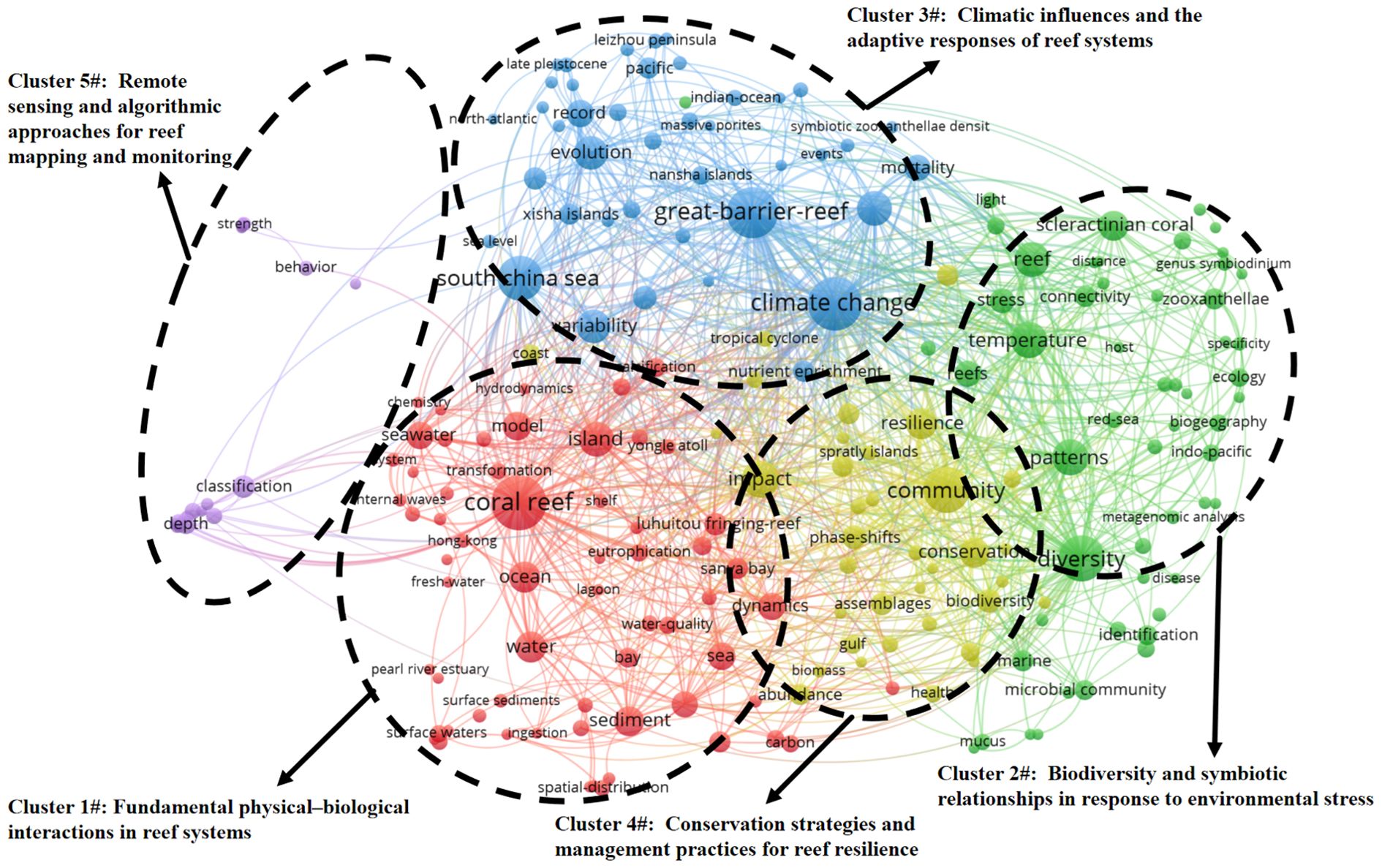- 1Island Research Center, Ministry of Natural Resources (MNR), Fuzhou, Fujian, China
- 2Fujian Provincial Key Laboratory of Island Conservation and Development, Fuzhou, Fujian, China
- 3Observation and Research Station of Island and Coastal Ecosystem in the Western Taiwan Strait, Ministry of Natural Resources (MNR), Xiamen, Fujian, China
- 4Institute of Geographic Sciences and Natural Resources Research Chinese Academy of Sciences, Beijing, China
The South China Sea, a key biodiversity hotspot in the Central Indo-Pacific, hosts a rich array of coral reef species and marine life but faces growing threats from climate change and human activities. This study systematically analyzes coral reef research in the region using a bibliometric analysis of records from the Web of Science Core Collection. The analysis highlights the diverse roles of contributing countries and their collaborations, with China emerging as a significant contributor to the regional scientific output. Our findings categorize the research into five principal themes through text mining and bibliographic coupling: (1) fundamental physical-biological interactions within reef systems, (2) biodiversity and symbiotic relationships in response to environmental stress, (3) climatic influences and the adaptive responses of reef systems, (4) conservation strategies and management practices for reef resilience, and (5) remote sensing and algorithmic approaches for reef mapping and monitoring. The discussion addresses regional challenges, outlines the identified research framework, and details key trends in South China Sea coral reef research, thereby providing essential information to guide future development and conservation efforts.
1 Introduction
The South China Sea, encompassing over 3 million km² within the Central Indo-Pacific marine realm, is a critical hotspot for global coral reef biodiversity (Morton and Blackmore, 2001; Spalding et al., 2007). Southeast Asia, widely recognized as the global epicenter of coral reef diversity, contains approximately 34% of the world’s coral reefs despite occupying only 2.5% of the Earth’s total sea surface (Arai, 2015). Within this region, the South China Sea supports more than half of Southeast Asia’s hard coral species diversity, hosting 571 known reef coral species—a richness comparable to that of the adjacent Coral Triangle, despite comprising less than 17% of its reef area (Sanciangco et al., 2013; Huang et al., 2015). The region is also home to 3,365 marine fish species, accounting for 12% of the global fish catch and supporting the livelihoods of at least 3.7 million people through fisheries that rely on 55% of the world’s fishing fleet (Raymond and Welch, 2022). These coral reefs provide essential ecosystem services, including biodiversity maintenance, tourism, and coastal protection, providing habitat or food for an estimated 25% of all marine species (Hughes et al., 2017). Coral reefs also function as natural coastal defenses, reducing erosion and buffering against storm impacts. Furthermore, they are vital breeding and nursery grounds for both open-ocean and bottom-dwelling fish species, which in turn support regional capture fisheries (Oakley and Pilcher, 1996; Arai, 2015; Yuan et al., 2024).
Despite their ecological and socioeconomic significance, the coral reefs of the South China Sea face mounting pressures from both environmental degradation and geopolitical tensions (Xiao et al., 2022). For decades, territorial disputes involving China, Vietnam, the Philippines, Malaysia, Indonesia, and Brunei have persisted, with overlapping claims to territorial and maritime jurisdiction remaining unresolved (Welch, 2017). These conflicts, compounded by strategic interests from non-claimant states such as the United States, which champions freedom of navigation and the rule of law, have impeded cohesive conservation efforts (Raymond and Welch, 2022). Consequently, the South China Sea has received less conservation focus than the Coral Triangle, despite its comparable biodiversity and critical role in supporting human populations (Sanciangco et al., 2013).
Given these challenges, effective management of the South China Sea’s coral reefs requires a comprehensive understanding of existing research efforts. This study employs a bibliometric approach to systematically review research on coral reefs in the South China Sea, utilizing records from the Web of Science Core Collection. By analyzing publication trends, thematic priorities, and collaborative networks, we aim to map the evolution of the field and highlight key research areas. This synthesis provides a scientific basis for informing future research directions and management strategies to protect these vital ecosystems amid ongoing geopolitical and environmental pressures.
2 Methodology
2.1 Data
In order to extract as many relevant studies as possible from the target literature, using a well-structured research protocol has been widely highlighted in the literature as one of the most important prerequisites in conducting systematic reviews. On this basis, a structured search string was formulated using different combinations of the keywords “coral reefs” and “South China Sea” as the two main concepts that shape the present review. Considering the South China Sea is a politically sensitive and geographically complex area, with different countries and regions adopting distinct names and territorial claims, the various names and geographic terms used to refer to the South China Sea in different countries and regions were designed. Consequently, the following search string was constructed to collect articles from the Web of Science database: (“coral reef*” OR “reef-building coral*” OR “coral ecosystem*” OR “coral reef* ecosystem*” OR “coral community*”) AND (“South China Sea” OR “SCS” OR “Xisha*” OR “Nansha*” OR “Zhongsha*” OR “Paracel Islands” OR “Spratly Islands” OR “Scarborough Shoal” OR “Huangyan*” OR “Weizhou Island” OR “Dongsha*” OR “meiji*” OR “Yongxing*” OR “Macclesfield Bank”). The inclusion of terms such as “Xisha,” “Nansha,” and “Zhongsha” reflects the Chinese terminology, while “Paracel Islands,” “Spratly Islands,” and “Scarborough Shoal” correspond to internationally recognized names or terms used in neighboring countries. Table 1 summarizes the steps taken in this research to construct the final sample. The exclusive use of the Web of Science database for this study was primarily driven by its reputation as a consistent and reliable dataset for bibliometric mapping. This choice aligns with established practices in various research fields, including studies on biomass energy, climate change vulnerability, and cultural heritage (Wang et al., 2014; Mao et al., 2018; Vlase and Lähdesmäki, 2023).
2.2 Analysis approach
Bibliometric analysis is a statistical method used to evaluate extensive scientific output and has become widely adopted for mapping research fields (Wang et al., 2014; Syamimi et al., 2022; Zeng et al., 2024). By establishing links among articles, journals, authors, keywords, citations, and co-citation networks, it helps researchers identify key themes, emerging trends, and potential future developments. In this study, we employed VOSviewer (version 1.6.19, developed by Van Eck & Waltman) to perform our bibliometric analysis (van Eck and Waltman, 2010). We then mapped the scientific output on coral reefs in the South China Sea, focusing on key indicators such as: (i) geographical distribution of publications, (ii) author productivity and influence, (iii) core journals, (iv) influential articles, and (v) keyword analysis to uncover research trends and focal points. Additionally, we conducted a text mining analysis using a term co-occurrence algorithm on the titles and abstracts of 769 articles, utilizing the text mining module of VOSviewer (van Eck and Waltman, 2011), to further refine our sample.
The constructure of the map involves three key steps. Firstly, a similarity matrix is computed from the co-occurrence matrix. This process involves assessing the similarity between each pair of items by evaluating the frequency of their co-occurrences relative to their individual or joint occurrences with other items. Second, the VOS mapping technique positions items in a low-dimensional space by minimizing a weighted sum of squared Euclidean distances between all pairs, subject to the constraint that the average distance equals one to prevent trivial layouts. Finally, to overcome local optima, the resulting configuration is translated, rotated, and reflected, which preserves relative distances while ensuring a globally optimized solution (van Eck and Waltman, 2010). All the analysis is accomplished in the VOSviewer software.
3 Results
3.1 Results of literature quantity analysis
As can be seen from Figure 1, three distinct stages can be identified. Research on coral reefs in the South China Sea started relatively late, with the first related publications appearing in 1987. Before 2013, the number of publications fluctuated at a low level, with an average annual count of fewer than 20. From 2013 to 2019, the annual publication count increased steadily, ranging between 20 and 50. Since 2019, there has been a marked year-by-year increase in publications, reaching 101 papers by 2024. The count for 2025 only comprises publications up to March 15, which explains the lower figure.
3.2 Performance of countries, institutions, and authors
3.2.1 Cooperation network of countries
The spatial and geographic distribution of articles offers insight into the leading countries contributing to coral reef research in the South China Sea since 1999. A total of 45 regions have published articles in this field, with 42 of them forming part of a co-authorship network. Figure 2 illustrates the co-authorship network among these countries, where the size of each node represents the number of articles published by that region, and the thickness of the links reflects the strength of co-authorship ties between pairs of regions. Table 2 lists the top 10 regions ranked by the number of published articles, collaborating regions (number of links), total co-authored articles (total link strength), and the number of citations received.
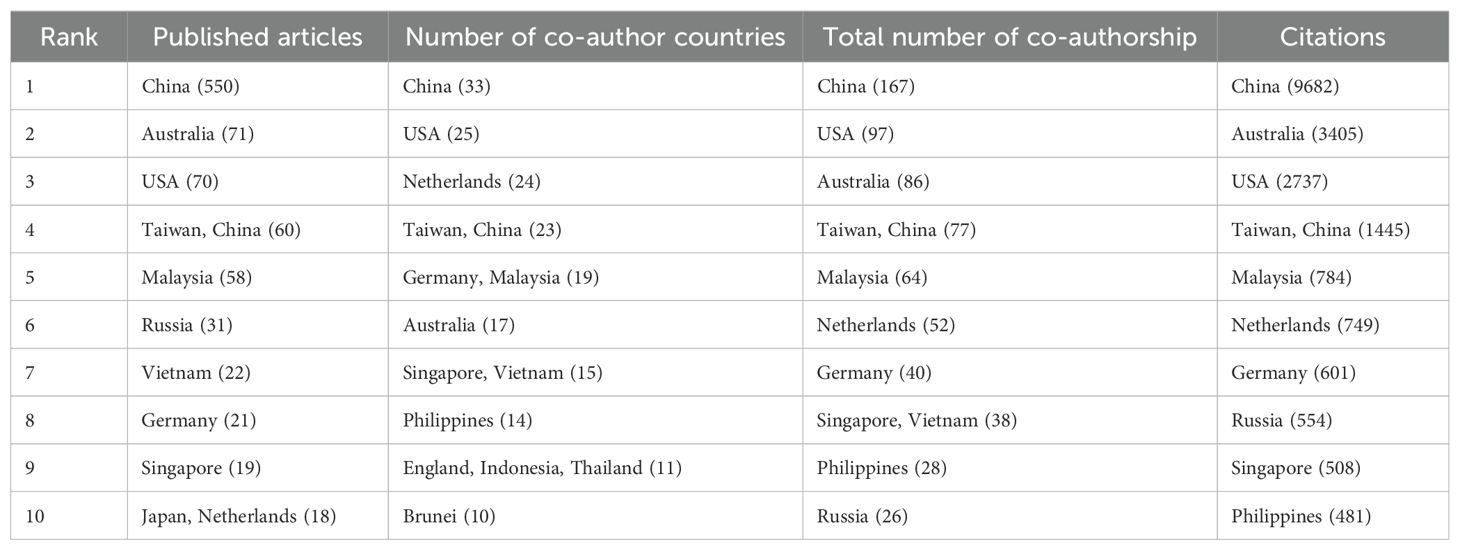
Table 2. Top 10 regions in terms of the number of published articles, number of co-author region, total number of co-authorship, and the number of cites to their articles.
As detailed in Table 2, China leads across all four metrics, with 550 published articles, 33 collaboration links, 167 co-authorships, and 9,682 citations. While the second and third positions vary by metric, Taiwan, China ranks fourth with 60 articles, 23 collaborating countries, 77 co-authorships, and 1,445 citations. Malaysia follows in fifth place with 58 articles, 19 collaborating countries, 64 co-authorships, and 784 citations. Australia, the USA, Germany, Singapore, and the Netherlands are consistently among the top 10 contributors across all four metrics, though their specific rankings vary. As shown by the strength of the links in Figure 2, China’s strongest collaborative ties are with the USA (38 co-authorships) and Australia (34 co-authorships), representing the most significant partnerships within the network.
3.2.2 Cooperation network of authors
Authors play a crucial role in evaluating the development of an academic field. A total of 2,661 authors have contributed to coral reef research in the South China Sea, with 112 authors having published at least five articles. Tables 3 and 4 list the most productive authors (based on the number of published articles) and the most influential authors (based on citation counts), respectively, along with their number of co-authors and co-authorships. According to these rankings, Yu Kefu is the most productive and influential author among the 2,661 contributors. Wang Yinghui ranks second in productivity and third in influence, while Huang Xueyong ranks third in productivity and second in influence.
3.2.3 Cooperation network of organizations
Understanding the leading organizations in a specific research area can be achieved by analyzing inter-organizational collaborations. To identify the key research institutions, we listed the top 10 organizations with the highest number of publications (Table 5) and created a co-authorship network map (Figure 3) using VOSviewer. Among the top 10 organizations, eight are from China, while the remaining two are from Australia and Malaysia. The Chinese Academy of Sciences leads with 250 publications, followed by Guangxi University with 113 publications. The other organizations have published fewer than 100 papers. In terms of Citations Per Paper (CPP), University of Queensland, ranked eighth in total publications, holds the highest CPP at 51.2. Xiamen University ranks second with a CPP of 22.5, followed by Chinese Academy of Sciences with 21 CPP.
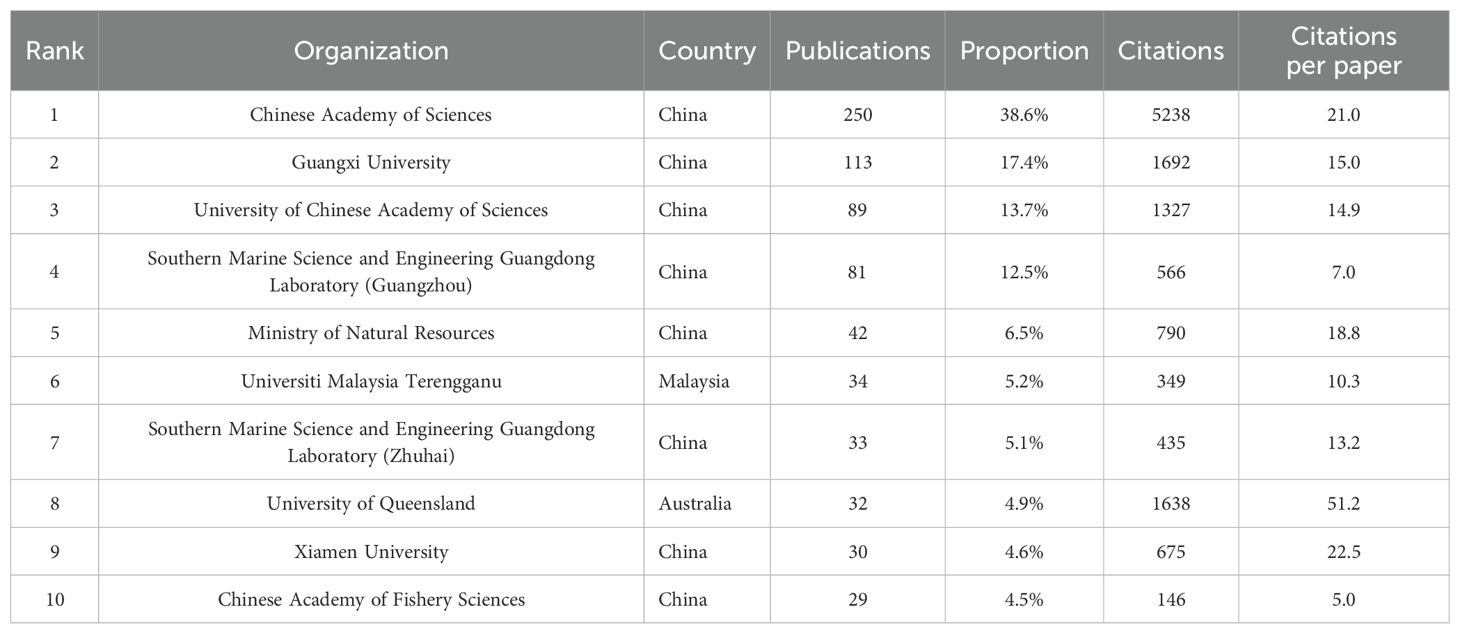
Table 5. Organizations with the most publications in the coral reef research in the South China Sea.
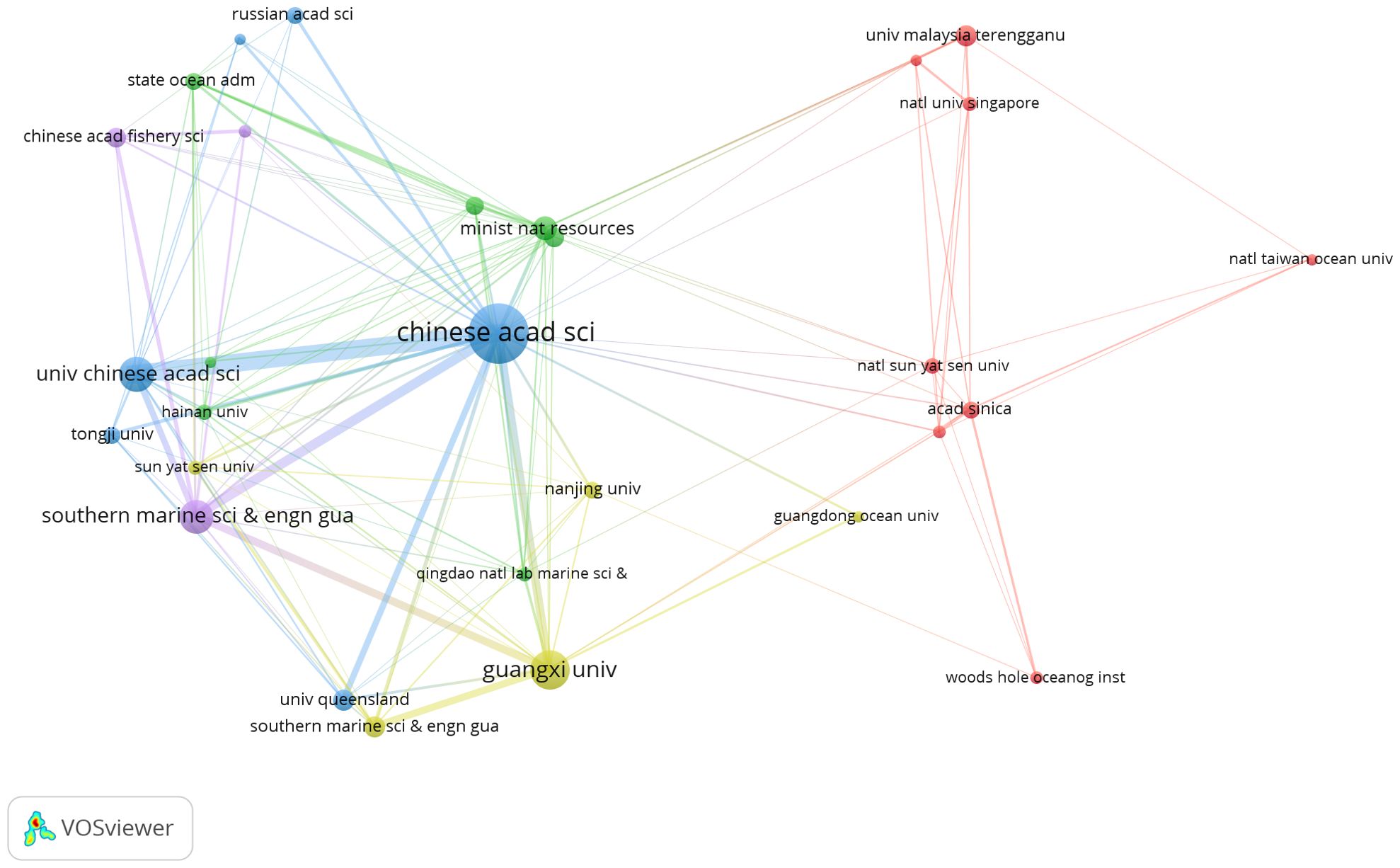
Figure 3. Mapping knowledge domain of coauthoring organizations in the coral reef research in the South China Sea.
Figure 3 shows the co-authorship network of research organizations, where each node represents an organization, with the node size indicating the number of publications. The thickness of the connecting lines reflects the strength of collaboration between two organizations. The Chinese Academy of Sciences appears as the largest node, followed by the University of Chinese Academy of Sciences and the Southern Marine Science and Engineering Guangdong Laboratory (Guangzhou). The Chinese Academy of Sciences also has the strongest collaborative ties with other institutions, with its closest connection to the University of Chinese Academy of Sciences, followed by the Southern Marine Science and Engineering Guangdong Laboratory (Guangzhou) and Guangxi University.
3.3 Performance of journals, citations, and keywords
3.3.1 Citation analysis on relevant journals
The 769 articles on coral reef research in the South China Sea within our dataset have been published in 275 journals. Among these, 42 journals have published at least five articles. Figures 4 and 5 present the top journals based on the number of published articles and citations, respectively. As shown in the figures, Science of the Total Environment leads in both the number of published articles and total citations. Frontiers in Marine Science ranks second in the number of published articles, while Marine Pollution Bulletin is the second most influential journal in terms of citations. Notably, there is a considerable gap between the second and third-ranked journals in both productivity and influence. Specifically, Science of the Total Environment and Frontiers in Marine Science have published 34 and 33 articles, respectively, while Marine Pollution Bulletin, the third-ranked journal in terms of productivity, has published 24 articles. Similarly, in terms of citations, Science of the Total Environment and Marine Pollution Bulletin have received 670 and 657 citations, respectively, which are significantly higher than the 479 citations received by Journal of Geophysical Research-Oceans. This highlights Science of the Total Environment as the leading journal in coral reef research in the South China Sea.
3.3.2 The analysis on articles
This section presents two primary analyses, focusing on the citations received by the articles and their bibliographic coupling.
3.3.2.1 Influential articles
One way to assess the influence of an article in a specific research field is by examining the number of times it has been cited. Table 6 lists the top 10 most cited articles on coral reef research in the South China Sea. As shown in the table, the most influential article, with 630 citations, is a study by (Murray et al., 2019) that highlights the global loss, degradation, and fragmentation of coastal ecosystems, including coral reefs, tidal flats, and mangroves. Similarly, a global review of nutrients, metals, persistent organic pollutants, and major environmental changes driven by climate change and their effects on coastal ecosystems ranks eighth with 227 citations (Lu et al., 2018).
At the regional scale, several influential articles focus on the South China Sea and surrounding areas. Montaggioni (2005), explores the postglacial development patterns of Indo-Pacific coral reefs, ranking second with 366 citations. Liu (2013) examines the biodiversity of tropical coral reefs, securing the third spot with 322 citations. The South China Sea’s biodiversity hotspots and associated challenges are discussed by (Morton and Blackmore, 2001), ranking fifth with 279 citations. Yu (2012) analyzes the ecological sensitivity and paleoenvironmental records of coral reefs in the South China Sea, ranking ninth with 206 citations.
Other influential studies focus on specific aspects of islands in the South China Sea. Wang et al. (2011) investigate the geotechnical properties of calcareous sands from Yongshu Reef, placing fourth in influence. Ding et al. (2019) discuss microplastic contamination in the coral reef ecosystems of the Xisha Islands, ranking tenth.
Moreover, novel methods for monitoring coral reef ecosystems are also featured among the most influential articles. Ma et al. (2020) introduces an approach integrating multi-satellite image analysis for empirical bathymetric mapping in shallow waters, validated in the Yongle Atoll, which ranks seventh. Li et al. (2021) propose using deep learning algorithms to extract coral reef information from underwater imagery, ranking sixth.
3.3.2.2 Bibliographic coupling of articles
In order to put the articles in relevant categories and show the main themes of the coral reef research, bibliometric coupling of the articles was conducted based on the references that they share. Out of the 769 research and review articles in our dataset, only 742 documents had at least one common reference with other documents. Therefore, these 742 articles were considered for the bibliographic coupling in this section. Figure 6 visualizes the articles grouped in three specific clusters, which was based on the Fractionalization method, with Attraction and Repulsion values set to 2 and -1, respectively. The Fractionalization method, by encompassing various similarity measures within a single parameterized formula, offers a unified framework that facilitates the comparison and interpretation of clustering outcomes (Van Eck and Waltman, 2009). These categories reflect strong internal connections between papers that share significant co-citations and thematic overlaps, identified through bibliographic coupling analysis. Each cluster is addressed by a different color and is named based on the main sense of the articles located in it. The size of the bubble points to the number of citations of the corresponding article and the link between each pair of articles shows their co-occurrence. The top 10 highly cited articles of each category are listed in Table 7.
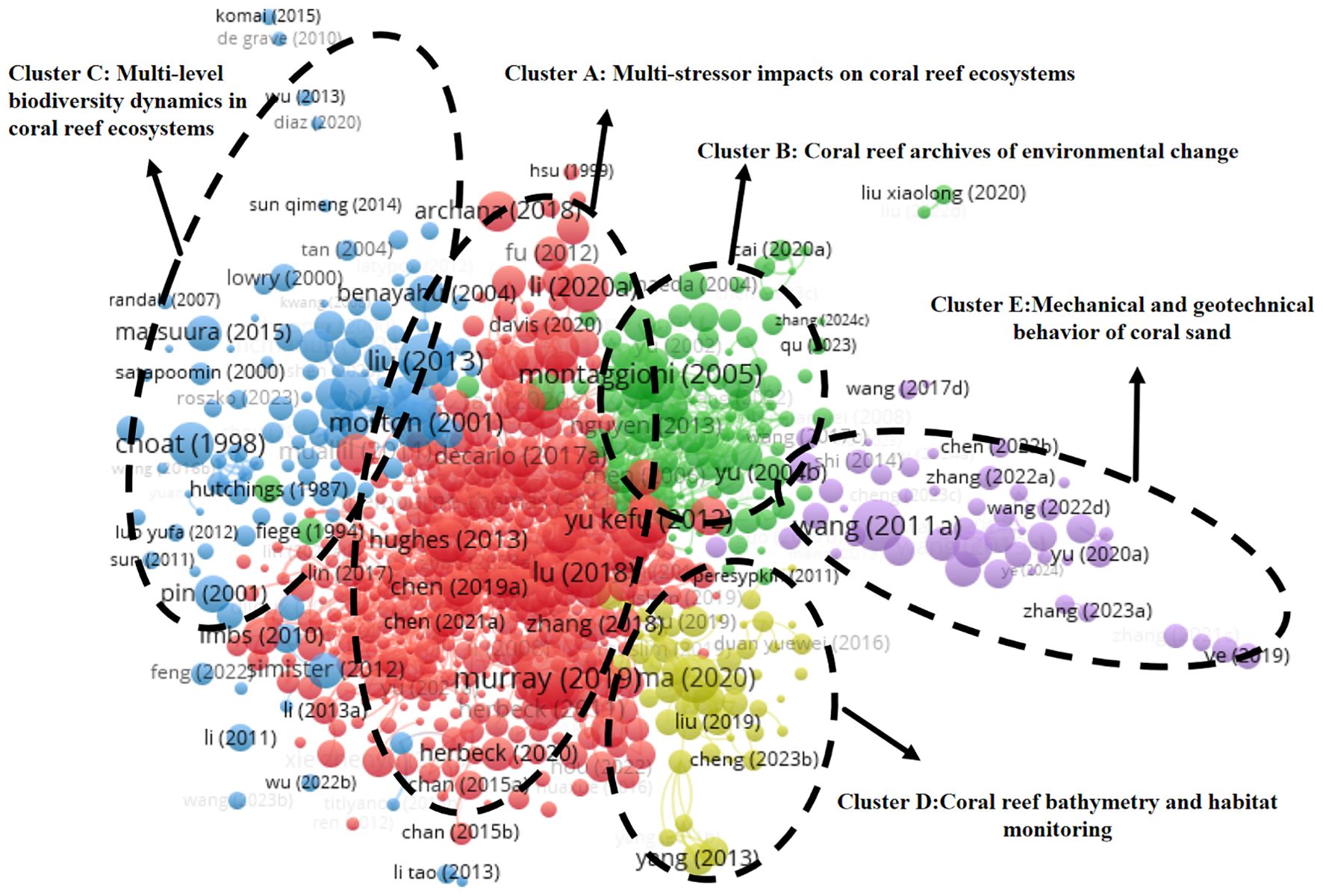
Figure 6. Bibliographic coupling of the articles within the field of coral reefs in the South China Sea.
The focus of the majority of the papers in research category A (red color in Figure 6) is on the multi-stressor impacts on coral reef ecosystems in the South China Sea. Coral cover in South China Sea has declined from an average of>60% to around 20% from 1990s to 2012 (Hughes et al., 2013). The increasing frequency and duration of marine heatwaves are closely linked to coral bleaching events, acting as a major stressor (Yao and Wang, 2021). Yu et al. (2012) further links historical bleaching episodes to El Niño-induced SST spikes, noting that recovery from mid-Holocene thermal stress required 10–30 years. Ocean acidification caused by rising atmospheric CO2 levels (Dai et al., 2009) and microplastic contamination (Ding et al., 2019) place additional pressure on reef ecosystems. Moreover, nutrient enrichment from agricultural runoff (Archana et al., 2018), typhoon-induced runoff (Herbeck et al., 2011), and terrestrial pollutants delivered to reefs through river plumes (Lu et al., 2018) have been shown to alter reef biogeochemistry, further hindering coral recovery.
Coral reef archives of environmental change represent a key focus of research category B, highlighted in green in Figure 6. These studies use coral skeletal geochemistry and stratigraphic records to reconstruct past environmental variations over multiple timescales, ranging from centennial-scale winter cooling events (Yu et al., 2004b) to 160-year cycles of extreme weather patterns (Yu et al., 2004a). Additionally, coral skeletal trace metal records, such as rare earth elements (REEs), Ba/Ca, and Mn/Ca ratios, help assess anthropogenic impacts on a decadal scale (Nguyen et al., 2013; Saha et al., 2016). Historical sea-level reconstructions have also been employed to trace reef initiation during the Early Miocene (Fan et al., 2020) and to evaluate its impact on carbonate platform evolution (Shao et al., 2017), while also providing insights into long-term shifts in reef communities (Montaggioni, 2005; Wilson, 2008).
Research category C (shown in blue in Figure 6) primarily comprises studies focused on multi-level biodiversity dynamics within coral reef ecosystems. Numerous authors have documented the high diversity of marine species in the South China Sea (McManus, 1994; Morton and Blackmore, 2001; Liu, 2013). Factors such as depth, ocean currents, environmental stress, and hydrographic barriers are recognized as key influences on coral reef biodiversity (Pin et al., 2001; Benayahu et al., 2004; Kool et al., 2011; Simister et al., 2012; Huang et al., 2015). Additionally, foundational work on the nutritional ecology of marine vertebrate herbivores and the identification of new taxa, primarily from coral reefs and tropical freshwater systems, has been reported (Choat and Clements, 1998; Matsuura, 2015).
Category D (highlighted in yellow in Figure 6) focuses on coral reef bathymetry and habitat monitoring, a field that has seen notable progress through the integration of multispectral remote sensing and machine learning. These advancements have addressed three key challenges: (1) overcoming data scarcity using ICESat-2/MODIS multi-sensor fusion (Hu et al., 2014; Ma et al., 2020); (2) improving depth retrieval accuracy by combining machine learning with physical models (Liu et al., 2019; Xu et al., 2021b; Wu et al., 2022); and (3) enhancing habitat monitoring reliability through multi-dimensional feature engineering (Zhou et al., 2018; Su et al., 2019). In addition, early studies in this field explored statistical algorithms and geochemical methods for mapping water depth and monitoring environmental conditions (Yang et al., 2013, 2015; Huang et al., 2017).
Research category E (highlighted in purple in Figure 6) primarily comprises studies on the mechanical and geotechnical behavior of coral sand. Wang Xinzhi is a pioneering researcher in this field, having published six of the top ten articles. His work addresses critical aspects such as bearing capacity (Wang et al., 2011, 2021), particle obstruction due to irregular grain geometries (Wang et al., 2019), shear characteristics (Wang et al., 2017a), and permeability (Wang et al., 2017b, 2018). Zhu Changqi has contributed two of the top ten articles, focusing on sedimentary evolution and identifying key parameters that control strength (Zhu et al., 2014; Chang-Qi et al., 2016). Additionally, recent studies have explored microscale sand mechanics and creep characteristics (Ye et al., 2022; Gao and Ye, 2023).
The five identified categories collectively serve the critical aims of addressing climate change and ensuring coral reef protection. Category A is dedicated to understanding the current multi-stressor impacts on coral reef ecosystems. In contrast, Category B utilizes coral reef records to reconstruct past environmental conditions, offering potential insights that can inform protective measures. Category C underscores the ecological significance of coral reefs through its focus on biodiversity. Providing foundational data for conservation, Category D investigates coral reef bathymetry and facilitates habitat monitoring. Lastly, Category E explores the unique mechanical and geotechnical characteristics of coral sand, advocating for its long-term viability in coastal construction due to its inherent resistance to erosion and degradation in saline and severe weather conditions (Hasan et al., 2024).
3.3.3 The analysis on keywords co-occurrence
The analysis of keyword frequency provides a basis for describing the research domain and the focus of the collected articles. After cleaning the keyword data, 2,179 unique keywords were identified, of which 112 appeared at least four times. A heat map of these 112 keywords, based on their frequencies, was generated using VOSviewer (Figure 7). Since South China Sea and coral reef were part of the search query, they appear significantly more frequently than other terms and are therefore excluded from Figure 7 to allow for a clearer analysis of the research domain. Beyond these terms, the most frequently occurring keywords are coral, climate change, and coral bleaching, aligning with the research categories identified through the bibliographic coupling analysis. To facilitate the identification of the most frequent terms, author keywords with more than ten occurrences are listed in Table 8.
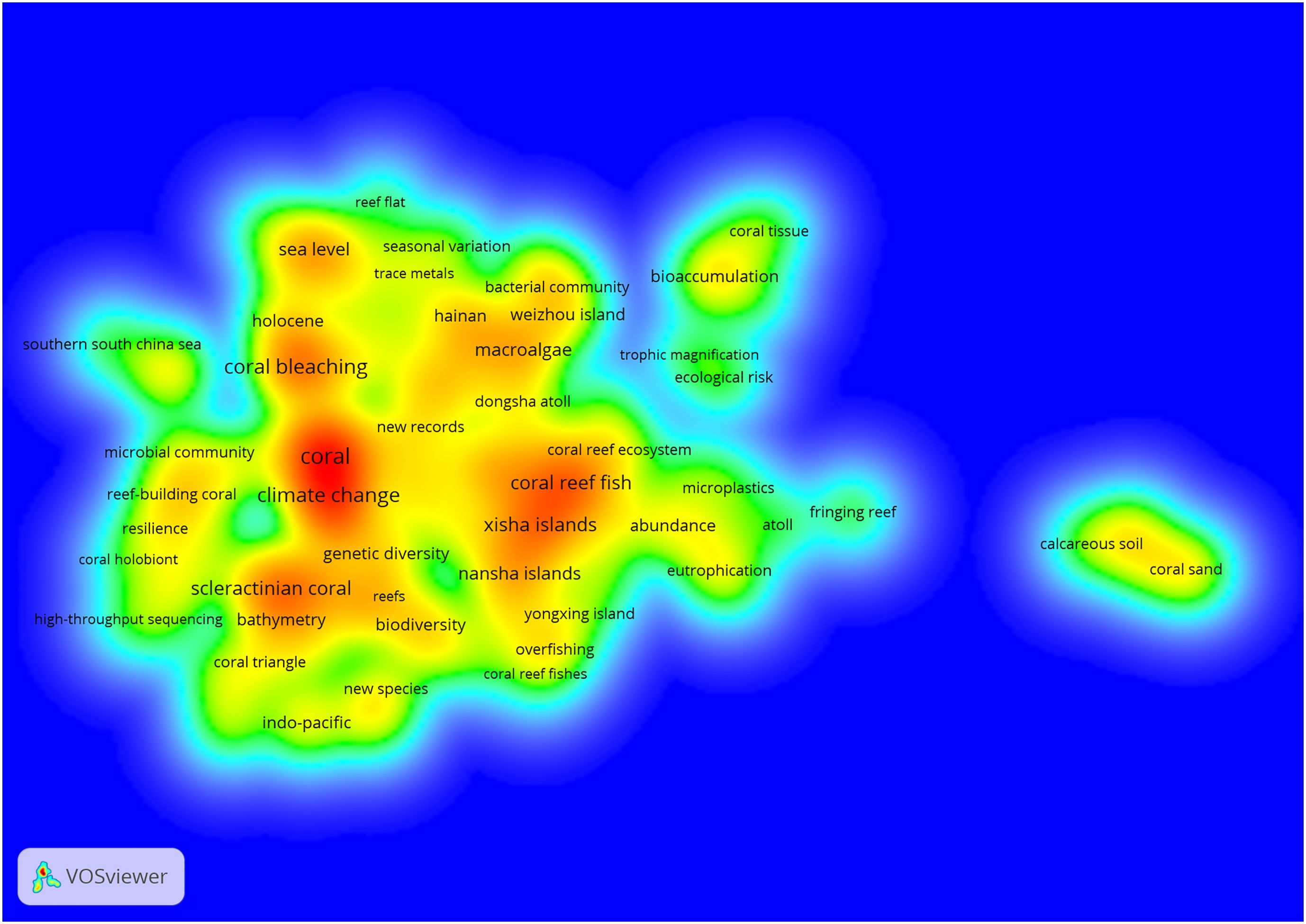
Figure 7. The density visualization map of author keywords within the articles in the research domain.
Table 8 shows that most research has been conducted in the Xisha Islands, Malaysia, the Nansha Islands, Hainan, and the northern South China Sea. The primary research subjects are reflected in the keywords coral, coral reef fish, Scleractinian coral, diversity and coral community. The major research focus includes the negative impacts of climate change, macroalgae proliferation, sea level rise, and global warming, with coral bleaching identified as the most pressing issue. Regarding research methods, remote sensing emerges as the dominant approach. This technology enables detailed classification of complex reef benthic substrates and facilitates the investigation and assessment of coral reef health, driving significant progress in the field (Xu and Zhao, 2014). With rapid advancements in remote sensing data sources, spectral characteristics analysis, and recognition technologies, this method has gained increasing popularity. Its capacity for large-scale coverage and non-invasive monitoring makes it especially valuable for studying coral reef ecosystems (AlZayer et al., 2025; Huang et al., 2025; Liu et al., 2025).
3.3.4 Text mining results: thematic conceptualization
The text mining analysis was conducted on the titles and abstracts of the collected peer-reviewed journal articles of our sample to uncover hidden semantic structures and research themes. After cleaning the data, 4134 unique noun phrases were identified. In order to base the analysis on the sufficiently frequent terms, a minimum of 5 occurrences was considered as a criterion for the selection of phrases, leading to the selection of 281 noun phrases. Then, the phrases were used to build clusters based on the co-occurrence of the terms to reveal the research themes of coral reef in the South China Sea. The 5 major theme identified includes (1) fundamental physical–biological interactions in reef systems, (2) biodiversity and symbiotic relationships in response to environmental stress, (3) climatic influences and the adaptive responses of reef systems, (4) conservation strategies and management practices for reef resilience, (5) remote sensing and algorithmic approaches for reef mapping and monitoring. Figure 8 presents the thematic structure of the coral reef research in the South China Sea. Similar to Figure 7, the size of the circles and the links between them show the occurrence of identified terms and their co-occurrence, respectively.
The first thematic cluster focuses on fundamental physical–biological interactions in reef systems (Cluster #1). Keywords central to this research theme include “coral reef”, “island”, “ocean”, “water”, “sediment”, “model”, “dynamics”, “fish”, “organic-matter”, “calcification”. These terms reflect the interplay between physical factors—such as ocean currents, water characteristics, and sediment movement—and biological processes, like fish populations, organic matter cycling, and calcification (Wilson, 2008; Xu et al., 2011; Shao et al., 2017; Zhang et al., 2021; Fan et al., 2024). Overfishing has been found in Nansha Islands and in the Malaysian South China Sea, which causes the “coral reef crisis” (Bell et al., 2006; Arai, 2015; Zhang et al., 2021). Parrotfish play a crucial regulatory role in coral reef ecosystems, and their susceptibility to fishing activities could lead to a gradual transition towards algal dominance, resulting in ecological phase shifts (Wang et al., 2024). Models play a critical role in examining these interactions, offering insights into reef dynamics across different scenarios (Melbourne-Thomas et al., 2011). This cluster highlights the combined impact of geophysical and ecological processes on coral reef development and function.
The second research theme (Cluster #2) concentrates on biodiversity and symbiotic relationships in response to environmental stress. It encompasses concepts such as “diversity”, “patterns”, “temperature”, “reef”, “stress”, “zooxanthellae”, “connectivity”, and “microbial community”. Research indicates that richness, rarity, and phylogenetic diversity vary significantly among reef areas in the South China Sea, and outcomes following projected extinctions cannot be predicted by species diversity alone (Huang et al., 2016). In the South China Sea, corals exhibit varying patterns of adaptability: those in the southern region are primarily threatened by thermal stress, while northern corals often suffer from severe anthropogenic disturbances (Qin et al., 2020). Moreover, rising ocean temperatures have been widely linked to coral reef bleaching, typically marked by the expulsion of symbiotic zooxanthellae, loss of zooxanthellae pigmentation, or both (Li et al., 2008). Coral-associated bacterial communities, which are essential for coral ecosystems and holobiont health (Yu et al., 2021), undergo substantial structural changes during bleaching events (Yang et al., 2021). Collectively, these findings demonstrate how biodiversity and symbiotic interactions influence coral reef responses to environmental challenges, offering vital insights for developing effective conservation strategies.
The third thematic cluster explores climatic influences and the adaptive responses of reef systems (Cluster #3). Key terms such as “climate change”, “Great Barrier Reef”, “growth”, “variability”, “evolution”, “record”, “mortality”, and “ocean acidification” are central to this theme. Climate change affects coral reefs primarily through rising ocean temperatures and acidification, which may prevent some corals from surviving in tropical regions if they cannot adapt quickly enough (Yuan et al., 2019). Persistent seawater warming is recognized as a major threat to coral growth and reef development, with overall coral growth in the South China Sea projected to decline by the end of this century (Yan et al., 2019). The Great Barrier Reef, one of the most extensively studied coral reef systems, has provided research methodologies applicable to the South China Sea, such as the Foraminifera in Reef Assessment and Monitoring (FORAM) Index (A’ziz et al., 2021). Coral reefs in both the South China Sea and the Great Barrier Reef are experiencing declines, with mortality patterns in the Nansha area resembling those observed in the central Great Barrier Reef (Yu et al., 2012).
Conservation strategies and management practices for reef resilience (Cluster #4) have emerged as a leading research focus. The key terms in this theme are “community”, “impact”, “resilience”, “conservation”, “biodiversity”, “phase-shifts”, “assemblages”, “abundance”, “management”, “recovery”, “responses”, “coast”, and “coral cover”. Reefs in the South China Sea display spatial heterogeneity in resilience, recovery, and vulnerability to elevated water temperatures, as evidenced by variations in parameters such as coral cover and genus diversity. This variability necessitates targeted management interventions to guide reef rehabilitation for both biodiversity conservation and touristic development, involving relevant stakeholders (Vo et al., 2019). Notably, a phase shift from stony coral communities to alternative assemblages of octocorals and corallimorpharians has been observed in the South China Sea, attributed to outbreaks of crown-of-thorns starfish (Tkachenko et al., 2022). Reef restoration is recognized as an essential intervention to mitigate degradation. Moreover, these efforts have increased coastal community awareness of reef management and provided opportunities for active local participation and ownership (Chou et al., 2009).
The final thematic cluster highlights the application of remote sensing techniques and algorithmic approaches in reef mapping and monitoring (Cluster #5). Keywords associated with this research focus include “classification,” “depth,” “bathymetry,” “imagery,” “behavior,” “shallow waters,” “strength,” and “algorithm.” Shallow water depth estimation using multispectral imagery has become a vital method for marine surveying and mapping. To derive accurate bathymetric data, various algorithms such as the Quasi-Analytical Algorithm and geomorphic segmentation have been employed (Huang et al., 2017; Cheng et al., 2023; Zuo et al., 2024). Bathymetric data further support coral cover classification, enabling detailed assessment and monitoring of reef ecosystems (Asner et al., 2017). These advancements contribute to improved reef conservation and management strategies by enhancing the accuracy and efficiency of reef mapping efforts.
4 Discussion
4.1 Reginal challenges of the coral reef research in the South China Sea
The South China Sea is a critical biodiversity hotspot, supporting extensive coral reef ecosystems vital to ecological stability and regional livelihoods. However, research efforts on these reefs are unevenly distributed among neighboring countries. China has demonstrated a long-term commitment to coral reef research and conservation, contributing 550 publications, which outpacing other nations, and hosting eight of the top ten publishing institutions. From the Ridge-to-Reef perspective, effective reef management and coral survival demand integrated land–sea planning (Carlson et al., 2019), highlighting the need for enhanced reginal cooperation.
Data sharing is severely constrained by geopolitical tensions and overlapping territorial claims, which disrupt collaborative research and data exchange. While regional frameworks like the UNEP East Asian Seas Regional Seas Program and the UNEP/GEF South China Sea Project exist (Kao et al., 2012), their voluntary nature limits their effectiveness, with data sharing often restricted to specific project datasets (Tuan and Pernetta, 2010). The lack of binding mechanisms further complicates cross-border cooperation.
The livelihoods and economic realities of coastal communities pose further barriers to cooperation. Research indicates that coral reef study efforts correlate positively with per capita GDP and negatively with coral species richness (Fisher et al., 2011), reflecting the impact of human activities on reef health. Anthropogenic pressures, including nutrient enrichment (Guo et al., 2019), sewage discharge (Liu et al., 2012), and destructive fishing practices (Arai, 2015), accelerate reef degradation. Conservation measures, such as stricter pollution controls and fishing regulations, often impose economic burdens on coastal communities, diminishing their willingness to engage in research or support regional initiatives.
In summary, limited data sharing and socio-economic pressures collectively undermine regional cooperation in coral reef research within the South China Sea. Addressing these issues requires robust data exchange frameworks and strategies that balance conservation goals with community welfare to ensure sustainable management of this critical ecosystem.
4.2 Framework of the coral reef research in the South China Sea
Coral reef research in the South China Sea is built on a clear and organized framework, as evidenced by the alignment of text mining and bibliographic coupling analyses. Text mining extracts key themes from titles and abstracts, while bibliographic coupling groups studies based on shared references. Together, they reveal a research plan that starts with basic studies of physical and biological processes, such as ocean currents, sediment transport, and calcification, that form the foundation of reef ecosystems.
The research then moves to examine biodiversity and the ecological responses of reefs to stress, focusing on symbiotic interactions and resilience at both the organism and ecosystem levels. Finally, it addresses broader environmental challenges, including ocean warming and acidification, which pose serious threats to reef stability.
This logical progression from basic mechanisms to large-scale environmental impacts demonstrates the integration of marine biology, ecology, and climatology. Building on this foundation, the research extends into applied areas that focus on community management and conservation strategies aimed at reducing reef degradation and promoting recovery. These practical efforts are further supported by remote sensing techniques that improve monitoring accuracy and guide conservation actions.
The consistency between text mining and bibliographic coupling confirms the reliability of these themes, ranging from fundamental processes to biodiversity, climate impacts, management, and technological applications. This systematic framework not only advances scientific knowledge but also offers practical solutions for long-term conservation in this environmentally critical region.
4.3 Future trends in coral reef research in the South China Sea
Future research on coral reefs in the South China Sea will likely focus on two main areas: understanding the impacts of climate change and using new technology for better monitoring and management. Rising temperatures and ocean acidification are causing more frequent bleaching events, reduced coral calcification, and shifts in species diversity (McClanahan et al., 2007; Anthony et al., 2008; Kwiatkowski et al., 2015). Research will aim to clarify these changes using local studies and global models, helping us predict how reefs will respond to different climate scenarios. This work not only advances our scientific understanding but also supports global efforts to reduce greenhouse gas emissions and protect marine areas.
At the same time, technological innovation is transforming how we study coral reefs. Advances in satellite imagery, drones, and underwater sensors, combined with artificial intelligence, now allow for high-resolution, real-time data collection over large areas (Mohamed et al., 2018; Kaloop et al., 2022; Li and Hsu, 2022). These tools enable automated assessments of reef health, early detection of bleaching, and precise mapping of habitat changes (Xu et al., 2020, 2021a; Kopecky et al., 2023; Ma et al., 2023; Veeranjaneyulu et al., 2024). As these technologies continue to improve, they will help shift reef monitoring from reactive measures to proactive management, ensuring that conservation efforts are timely and effective.
5 Conclusion
This study employed bibliometric analysis to systematically review coral reef research in the South China Sea, utilizing records from the Web of Science Core Collection. Our analysis revealed a comprehensive research framework encompassing foundational studies of physical and biological processes, investigations into biodiversity responses to environmental stress, assessments of climate change impacts, and the development of advanced remote sensing techniques for reef monitoring, reflecting a multidisciplinary approach to reef science. However, challenges such as restricted data exchange and socio-economic pressures on coastal communities impede regional collaboration and effective management. Looking forward, future research should prioritize understanding the impacts of climate change and advancing innovative monitoring technologies to support sustainable management practices. Ultimately, our findings emphasize the necessity of a unified regional strategy that transcends geopolitical boundaries by leveraging scientific collaboration to ensure the long-term preservation of the South China Sea’s coral reefs.
Data availability statement
The original contributions presented in the study are included in the article/supplementary material. Further inquiries can be directed to the corresponding author.
Author contributions
JC: Writing – review & editing, Writing – original draft. FT: Resources, Writing – original draft. HL: Writing – original draft, Supervision. BH: Visualization, Writing – review & editing. XL: Validation, Writing – review & editing.
Funding
The author(s) declare that financial support was received for the research and/or publication of this article. This work is supported by the Research Project on Representative Islands Platform for Resources, Ecology, and Sustainable Development (No: 102121221620000009001) and the Fujian Provincial Natural Science Foundation of China (No. 2022J05098).
Conflict of interest
The authors declare that the research was conducted in the absence of any commercial or financial relationships that could be construed as a potential conflict of interest.
Generative AI statement
The author(s) declare that Generative AI was used in the creation of this manuscript. Polish language and improve readability. All AI-generated text and any outputs were critically reviewed, edited, and approved by the authors to ensure factual accuracy, compliance with Frontiers’ AI disclosure policy, and freedom from plagiarism.
Publisher’s note
All claims expressed in this article are solely those of the authors and do not necessarily represent those of their affiliated organizations, or those of the publisher, the editors and the reviewers. Any product that may be evaluated in this article, or claim that may be made by its manufacturer, is not guaranteed or endorsed by the publisher.
References
A’ziz A. N. A., Minhat F. I., Pan H. J., Shaari H., Saelan W. N. W., Azmi N., et al. (2021). Reef foraminifera as bioindicators of coral reef health in southern South China Sea. Sci. Rep. 11, 1–13. doi: 10.1038/s41598-021-88404-3
AlZayer Z., Mason P., Platt R., and John C. M. (2025). An improved machine learning-based method for unsupervised characterisation for coral reef monitoring in earth observation time-series data. Remote Sens. 17, 1244. doi: 10.3390/RS17071244
Anthony K. R. N., Kline D. I., Diaz-Pulido G., Dove S., and Hoegh-Guldberg O. (2008). Ocean acidification causes bleaching and productivity loss in coral reef builders. Proc. Natl. Acad. Sci. U.S.A. 105, 17442–17446. doi: 10.1073/pnas.0804478105
Arai T. (2015). Diversity and conservation of coral reef fishes in the Malaysian South China Sea. Rev. Fish Biol. Fish 25, 85–101. doi: 10.1007/S11160-014-9371-9/METRICS
Archana A., Thibodeau B., Geeraert N., Xu M. N., Kao S. J., and Baker D. M. (2018). Nitrogen sources and cycling revealed by dual isotopes of nitrate in a complex urbanized environment. Water Res. 142, 459–470. doi: 10.1016/j.watres.2018.06.004
Asner G. P., Martin R. E., and Mascaro J. (2017). Coral reef atoll assessment in the South China Sea using Planet Dove satellites. Remote Sens. Ecol. Conserv. 3, 57–65. doi: 10.1002/RSE2.42
Bell J. D., Ratner B. D., Stobutzki I., and Oliver J. (2006). Addressing the coral reef crisis in developing countries. Ocean Coast. Manag. 49, 976–985. doi: 10.1016/J.OCECOAMAN.2005.12.001
Benayahu Y., Jeng M. S., Perkol-Finkel S., and Dai C. F. (2004). Soft corals (Octocorallia: Alcyonacea) from Southern Taiwan. II. Species diversity and distributional patterns. Zool. Stud. 43(3):548–560.
Carlson R. R., Foo S. A., and Asner G. P. (2019). Land use impacts on coral reef health: A ridge-to-reef perspective. Front. Mar. Sci. 6. doi: 10.3389/FMARS.2019.00562/XML/NLM
Chang-Qi Z., Hai-Feng L., and Bin Z. (2016). Micro-structures and the basic engineering properties of beach calcarenites in South China Sea. Ocean Eng. 114, 224–235. doi: 10.1016/j.oceaneng.2016.01.009
Cheng J., Cheng L., Chu S., Li J., Hu Q., Ye L., et al. (2023). A comprehensive evaluation of machine learning and classical approaches for spaceborne active-passive fusion bathymetry of coral reefs. ISPRS Int. J. Geo Inform. 12, 381. doi: 10.3390/IJGI12090381
Choat J. H. and Clements K. D. (1998). Vertebrate herbivores in marine and terrestrial environments: A nutritional ecology perspective. Annu. Rev. Ecol. Syst. 29, 375–403. doi: 10.1146/annurev.ecolsys.29.1.375
Chou L. M., Yeemin T., Yaman A. R. B. G., Vo S. T., Alino P., and Suharsono (2009). Coral reef restoration in the South China Sea. Galaxea J. Coral Reef Stud. 11, 67–74. doi: 10.3755/GALAXEA.11.67
Dai M., Lu Z., Zhai W., Chen B., Cao Z., Zhou K., et al. (2009). Diurnal variations of surface seawater pCO2 in contrasting coastal environments. Limnol. Oceanogr. 54, 735–745. doi: 10.4319/lo.2009.54.3.0735
Ding J., Jiang F., Li J., Wang Z., Sun C., Wang Z., et al. (2019). Microplastics in the coral reef systems from Xisha Islands of South China Sea. Environ. Sci. Technol. 53, 8036–8046. doi: 10.1021/acs.est.9b01452
Fan R., Wei H., Mai Y., Zhang L., Yu J., and Wang D. (2024). Observations of waves and currents on the fore-reef and reef flat of a coral reef atoll in the South China Sea. Front. Mar. Sci. 11. doi: 10.3389/FMARS.2024.1460450
Fan T., Yu K., Zhao J., Jiang W., Xu S., Zhang Y., et al. (2020). Strontium isotope stratigraphy and paleomagnetic age constraints on the evolution history of coral reef islands, northern South China Sea. Bull. Geol. Soc. America 132, 1460450. doi: 10.1130/B35088.1
Fisher R., Radford B. T., Knowlton N., Brainard R. E., Michaelis F. B., and Caley M. J. (2011). Global mismatch between research effort and conservation needs of tropical coral reefs. Conserv. Lett. 4, 64–72. doi: 10.1111/J.1755-263X.2010.00146.X
Gao R. and Ye J. (2023). Mechanical behaviors of coral sand and relationship between particle breakage and plastic work. Eng. Geol. 316, 107063. doi: 10.1016/j.enggeo.2023.107063
Goodkin N. F., Switzer A. D., McCorry D., DeVantier L., True J. D., Hughen K. A., et al. (2011). Coral communities of Hong Kong: Long-lived corals in a marginal reef environment. Mar. Ecol. Prog. Ser. 426, 185–196. doi: 10.3354/meps09019
Guo J., Yu K., Wang Y., Zhang R., Huang X., and Qin Z. (2019). Potential impacts of anthropogenic nutrient enrichment on coral reefs in the South China Sea: evidence from nutrient and chlorophyll a levels in seawater. Environ. Sci. Process Impacts 21, 1745–1753. doi: 10.1039/C9EM00331B
Hasan M. M., Kabir M. B., Prodhan M. S. R., Anik M. S., Zubaer A., Hasan M. R., et al. (2024). The physical and mechanical properties of coral sand. Eur. J. Theor. Appl. Sci. 2, 313–337. doi: 10.59324/ejtas.2024.2(1).27
Herbeck L. S., Unger D., Krumme U., Liu S. M., and Jennerjahn T. C. (2011). Typhoon-induced precipitation impact on nutrient and suspended matter dynamics of a tropical estuary affected by human activities in Hainan, China. Estuar. Coast. Shelf Sci. 93, 375–388. doi: 10.1016/j.ecss.2011.05.004
Hu L., Liu Z., Liu Z., Hu C., and He M. X. (2014). Mapping bottom depth and albedo in coastal waters of the South China Sea islands and reefs using Landsat TM and ETM+ data. Int. J. Remote Sens. 35, 4156–4172. doi: 10.1080/01431161.2014.916441
Huang D., Hoeksema B. W., Affendi Y. A., Ang P. O., Chen C. A., Huang H., et al. (2016). Conservation of reef corals in the South China Sea based on species and evolutionary diversity. Biodivers. Conserv. 25, 331–344. doi: 10.1007/S10531-016-1052-7/METRICS
Huang D., Licuanan W. Y., Hoeksema B. W., Chen C. A., Ang P. O., Huang H., et al. (2015). Extraordinary diversity of reef corals in the South China Sea. Mar. Biodivers. 45, 157–168. doi: 10.1007/S12526-014-0236-1/METRICS
Huang R., Yu K., Wang Y., Wang J., Mu L., and Wang W. (2017). Bathymetry of the coral reefs of Weizhou Island based on multispectral satellite images. Remote Sens. 9, 750. doi: 10.3390/RS9070750
Huang W., Zhao J., Li M., Lou Q., Yan N., and Sun S. (2025). Assessment of atmospheric correction methods in MSI imagery for deriving bathymetry and substrates of shallow-water coral reefs. Front. Mar. Sci. 12. doi: 10.3389/FMARS.2025.1495793/BIBTEX
Hughes T. P., Barnes M. L., Bellwood D. R., Cinner J. E., Cumming G. S., Jackson J. B. C., et al. (2017). Coral reefs in the Anthropocene. Nature 546, 82–90. doi: 10.1038/nature22901
Hughes T. P., Huang H., and Young M. A. L. (2013). The wicked problem of China’s disappearing coral reefs. Conserv. Biol. 27, 4156–4172. doi: 10.1111/j.1523-1739.2012.01957.x
Kaloop M. R., El-Diasty M., Hu J. W., and Zarzoura F. (2022). Hybrid artificial neural networks for modeling shallow-water bathymetry via satellite imagery. IEEE Trans. Geosci. Remote Sens. 60, 1–11. doi: 10.1109/TGRS.2021.3107839
Kao S. M., Pearre N. S., and Firestone J. (2012). Regional cooperation in the South China Sea: Analysis of existing practices and prospects. Ocean Dev. Int. Law 43, 283–295. doi: 10.1080/00908320.2012.698926
Kool J. T., Paris C. B., Barber P. H., and Cowen R. K. (2011). Connectivity and the development of population genetic structure in Indo-West Pacific coral reef communities. Global Ecol. Biogeogr. 20, 695–706. doi: 10.1111/j.1466-8238.2010.00637.x
Kopecky K. L., Pavoni G., Nocerino E., Brooks A. J., Corsini M., Menna F., et al. (2023). Quantifying the loss of coral from a bleaching event using underwater photogrammetry and AI-assisted image segmentation. Remote Sens. (Basel) 15, 4077. doi: 10.3390/rs15164077
Kwiatkowski L., Cox P., Halloran P. R., Mumby P. J., and Wiltshire A. J. (2015). Coral bleaching under unconventional scenarios of climate warming and ocean acidification. Nat. Clim. Chang. 5, 777–781. doi: 10.1038/nclimate2655
Li W. and Hsu C. Y. (2022). GeoAI for large-scale image analysis and machine vision: recent progress of artificial intelligence in geography. ISPRS Int. J. Geoinf. 11, 385. doi: 10.3390/ijgi11070385
Li X., Liu B., Zheng G., Ren Y., Zhang S., Liu Y., et al. (2021). Deep-learning-based information mining from ocean remote-sensing imagery. Natl. Sci. Rev. 7, 1584–1605. doi: 10.1093/NSR/NWAA047
Li S., Yu K. F., Shi Q., Chen T. R., Zhao M. X., and Zhao J. X. (2008). Interspecies and spatial diversity in the symbiotic zooxanthellae density in corals from northern South China Sea and its relationship to coral reef bleaching. Chin. Sci. Bull. 53, 295–303. doi: 10.1007/S11434-007-0514-4/METRICS
Liu J. Y. (2013). Status of marine biodiversity of the China Seas. PloS One 8, e50719. doi: 10.1371/journal.pone.0050719
Liu Y., Deng R., Qin Y., Cao B., Liang Y., Liu Y., et al. (2019). Rapid estimation of bathymetry from multispectral imagery without in situ bathymetry data. Appl. Opt. 58, 7538–7551. doi: 10.1364/ao.58.007538
Liu C., Gao W., Xing J., and Gong W. (2025). The identification of exposed beachrocks on South China Sea Islands based on UAV images. Remote Sens. 17, 1647. doi: 10.3390/RS17091647
Liu P. J., Meng P. J., Liu L. L., Wang J. T., and Leu M. Y. (2012). Impacts of human activities on coral reef ecosystems of southern Taiwan: A long-term study. Mar. pollut. Bull. 64, 1129–1135. doi: 10.1016/J.MARPOLBUL.2012.03.031
Lu Y., Yuan J., Lu X., Su C., Zhang Y., Wang C., et al. (2018). Major threats of pollution and climate change to global coastal ecosystems and enhanced management for sustainability. Environ. pollut. 239, 670–680. doi: 10.1016/J.ENVPOL.2018.04.016
Ma Y., Xu N., Liu Z., Yang B., Yang F., Wang X. H., et al. (2020). Satellite-derived bathymetry using the ICESat-2 lidar and Sentinel-2 imagery datasets. Remote Sens. Environ. 250, 112047. doi: 10.1016/j.rse.2020.112047
Ma Y., Zhang H., Cao W., and Wang J. (2023). Detection of coral bleaching in oceanic islands using normalized bottom reflectance change index from multispectral satellite imagery. IEEE Geosci. Remote Sens. Lett. 20, 1502105. doi: 10.1109/LGRS.2023.3282708
Mao G., Huang N., Chen L., and Wang H. (2018). Research on biomass energy and environment from the past to the future: A bibliometric analysis. Sci. Total Environ. 635, 1081–1090. doi: 10.1016/J.SCITOTENV.2018.04.173
Matsuura K. (2015). Taxonomy and systematics of tetraodontiform fishes: a review focusing primarily on progress in the period from 1980 to 2014. Ichthyol Res. 62, 72–113. doi: 10.1007/s10228-014-0444-5
McClanahan T. R., Ateweberhan M., Muhando C. A., Maina J., and Mohammed M. S. (2007). Effects of climate and seawater temperature variation on coral bleaching and mortality. Ecol. Monogr. 77, 503–525. doi: 10.1890/06-1182.1
Melbourne-Thomas J., Johnson C. R., Aliño P. M., Geronimo R. C., Villanoy C. L., and Gurney G. G. (2011). A multi-scale biophysical model to inform regional management of coral reefs in the western Philippines and South China Sea. Environ. Model. Softw. 26, 66–82. doi: 10.1016/J.ENVSOFT.2010.03.033
Mohamed H., Nadaoka K., and Nakamura T. (2018). Assessment of machine learning algorithms for automatic benthic cover monitoring and mapping using towed underwater video camera and high-resolution satellite images. Remote Sens. (Basel) 10, 773. doi: 10.3390/rs10050773
Montaggioni L. F. (2005). History of Indo-Pacific coral reef systems since the last glaciation: Development patterns and controlling factors. Earth Sci. Rev. 71, 1–75. doi: 10.1016/j.earscirev.2005.01.002
Morton B. and Blackmore G. (2001). South China Sea. Mar. pollut. Bull. 42, 1236–1263. doi: 10.1016/S0025-326X(01)00240-5
Murray N. J., Phinn S. R., DeWitt M., Ferrari R., Johnston R., Lyons M. B., et al. (2019). The global distribution and trajectory of tidal flats. Nature 565, 222–225. doi: 10.1038/s41586-018-0805-8
Nguyen A. D., Zhao J., Feng Y., Hu W., Yu K., Gasparon M., et al. (2013). Impact of recent coastal development and human activities on Nha Trang Bay, Vietnam: Evidence from a Porites lutea geochemical record. Coral Reefs 32, 181–193. doi: 10.1007/s00338-012-0962-4
Oakley S. and Pilcher N. (1996). “Marine Protected Areas for sustainable fisheries management: Layang Layang reef as a source of larvae in the South China Sea,” in Proceedings of workshop on aquaculture and sustainable reef fisheries(Kota Kinabalu, Sabah Malaysia). Available at: https://library.enaca.org/Grouper/Research/Wildseed/2000/0805.htm.
Pin L. C., Teen L. P., Ahmad A., and Usup G. (2001). Genetic diversity of Ostreopsis ovata (Dinophyceae) from Malaysia. Mar. Biotechnol. 3, 246–255. doi: 10.1007/s101260000073
Pope K. O. and Terrell J. E. (2008). Environmental setting of human migrations in the circum-Pacific region. J. Biogeogr. 35, 1–21. doi: 10.1111/j.1365-2699.2007.01797.x
Qin Z., Yu K., Liang Y., Chen B., and Huang X. (2020). Latitudinal variation in reef coral tissue thickness in the South China Sea: Potential linkage with coral tolerance to environmental stress. Sci. Total Environ. 711, 134610. doi: 10.1016/J.SCITOTENV.2019.134610
Raymond M. and Welch D. A. (2022). What’s really going on in the South China Sea? J. Curr. Southeast Asian Affairs 41, 214–239. doi: 10.1177/18681034221086291/ASSET/0F62B03A-BE92-4CCD-BD7B-F22924D65AEC/ASSETS/IMAGES/LARGE/10.1177_18681034221086291-FIG1.JPG
Saha N., Webb G. E., and Zhao J. X. (2016). Coral skeletal geochemistry as a monitor of inshore water quality. Sci. Total Environ. 566–567, 652–684. doi: 10.1016/j.scitotenv.2016.05.066
Sanciangco J. C., Carpenter K. E., Etnoyer P. J., and Moretzsohn F. (2013). Habitat availability and heterogeneity and the indo-pacific warm pool as predictors of marine species richness in the tropical Indo-Pacific. PloS One 8, e56245. doi: 10.1371/JOURNAL.PONE.0056245
Shao L., Cui Y., Qiao P., Zhang D., Liu X., and Zhang C. (2017). Sea-level changes and carbonate platform evolution of the Xisha Islands (South China Sea) since the Early Miocene. Palaeogeogr. Palaeoclimatol. Palaeoecol. 485, 504–516. doi: 10.1016/J.PALAEO.2017.07.006
Simister R., Taylor M. W., Tsai P., Fan L., Bruxner T. J., Crowe M. L., et al. (2012). Thermal stress responses in the bacterial biosphere of the great barrier reef sponge, rhopaloeides odorabile. Environ. Microbiol. 14, 3232–3246. doi: 10.1111/1462-2920.12010
Spalding M. D., Fox H. E., Allen G. R., Davidson N., Ferdaña Z. A., Finlayson M., et al. (2007). Marine ecoregions of the world: A bioregionalization of coastal and shelf areas. Bioscience 57, 573–583. doi: 10.1641/B570707
Su D., Yang F., Ma Y., Zhang K., Huang J., and Wang M. (2019). Classification of coral reefs in the South China Sea by combining airborne LiDAR bathymetry bottom waveforms and bathymetric features. IEEE Trans. Geosci. Remote Sens. 57, 815–828. doi: 10.1109/TGRS.2018.2860931
Syamimi M. A., Herman M. A. S., Norhidayah W. M. W., and Suziana H. (2022). Mapping major trends in global research in marine and coastal tourism: A bibliometric analysis. J. Sustain. Sci. Manag. 17, 196–213. doi: 10.46754/jssm.2022.08.012
Tkachenko K. S., Dung V. V., and Ha V. T. (2022). Phase shift from a stony-coral to a soft-coral community on a coral reef: a case study of an alternative state. Mar. Biol. Res. 18, 544–554. doi: 10.1080/17451000.2022.2153869
Tuan V. S. and Pernetta J. (2010). The UNEP/GEF South China Sea Project: Lessons learnt in regional cooperation. Ocean Coast. Manag. 53, 589–596. doi: 10.1016/j.ocecoaman.2010.06.011
Van Eck N. J. and Waltman L. (2009). How to normalize co-occurrence data? An analysis of some well-known similarity measures Nees Jan van Eck and Ludo Waltman REPORT SERIES. Sci. And Technol. 60(8): 1635–1651.
van Eck N. J. and Waltman L. (2010). Software survey: VOSviewer, a computer program for bibliometric mapping. Scientometrics 84, 523–538. doi: 10.1007/S11192-009-0146-3/FIGURES/7
van Eck N. J. and Waltman L. (2011). Text mining and visualization using VOSviewer. Available online at: https://arxiv.org/abs/1109.2058v1 (Accessed March 19, 2024).
Veeranjaneyulu R., Govindarajan D., Subramanian C., Devi D. U., Banerjee S., Edpuganti S. K., et al. (2024). Marine ecosystem monitoring: applying remote sensing and AI to track and predict coral reef health. Remote Sens. Earth Syst. Sci. 7, 486–499. doi: 10.1007/S41976-024-00141-Z/METRICS
Vlase I. and Lähdesmäki T. (2023). A bibliometric analysis of cultural heritage research in the humanities: The Web of Science as a tool of knowledge management. Humanit. Soc. Sci. Commun. 10, 1–14. doi: 10.1057/S41599-023-01582-5;SUBJMETA=2801,4007,4014,523;KWRD=COMPLEX+NETWORKS,SOCIOLOGY
Vo S. T., Hua T. T., and Phan K. H. (2019). A study of coral reef resilience and implications of adaptive management and rehabilitation in Khanh Hoa Province, Vietnam. Acta Oceanol. Sin. 38, 112–117. doi: 10.1007/S13131-019-1377-7/METRICS
Wang X., Ding H., Meng Q., Wei H., Wu Y., and Zhang Y. (2021). Engineering characteristics of coral reef and site assessment of hydraulic reclamation in the South China Sea. Constr. Build Mater. 300, 124263. doi: 10.1016/j.conbuildmat.2021.124263
Wang X. Z., Jiao Y. Y., Wang R., Hu M. J., Meng Q. S., and Tan F. Y. (2011). Engineering characteristics of the calcareous sand in Nansha Islands, South China Sea. Eng. Geol. 120, 40–47. doi: 10.1016/j.enggeo.2011.03.011
Wang B., Pan S. Y., Ke R. Y., Wang K., and Wei Y. M. (2014). An overview of climate change vulnerability: A bibliometric analysis based on Web of Science database. Natural Hazards 74, 1649–1666. doi: 10.1007/s11069-014-1260-y
Wang X. Z., Wang X., Chen J. W., Wang R., Hu M. J., and Meng Q. S. (2018). Experimental study on permeability characteristics of calcareous soil. Bull. Eng. Geol. Environ. 77, 1753–1762. doi: 10.1007/s10064-017-1104-6
Wang X. Z., Wang X., Jin Z. C., Meng Q. S., Zhu C. Q., and Wang R. (2017a). Shear characteristics of calcareous gravelly soil. Bull. Eng. Geol. Environ. 76, 561–573. doi: 10.1007/s10064-016-0978-z
Wang X. Z., Wang X., Jin Z. C., Zhu C. Q., Wang R., and Meng Q. S. (2017b). Investigation of engineering characteristics of calcareous soils from fringing reef. Ocean Eng. 134, 77–86. doi: 10.1016/j.oceaneng.2017.02.019
Wang X., Weng Y., Wei H., Meng Q., and Hu M. (2019). Particle obstruction and crushing of dredged calcareous soil in the Nansha Islands, South China Sea. Eng. Geol. 261, 105274. doi: 10.1016/j.enggeo.2019.105274
Wang M., Ye J., Zhang X., Tan F., Shi Q., Sun F., et al. (2024). Dynamic evolution of coral reef ecosystems in the South China Sea under global change: a comprehensive multidimensional numerical simulation. Coral Reefs 44, 309–319. doi: 10.1007/S00338-024-02606-5/METRICS
Welch D. A. (2017). The justice motive in East Asia’s territorial disputes. Group Decis. Negot. 26, 71–92. doi: 10.1007/S10726-016-9500-Z/METRICS
Wilson M. E. J. (2008). Global and regional influences on equatorial shallow-marine carbonates during the Cenozoic. Palaeogeogr. Palaeoclimatol. Palaeoecol. 265, 262–274. doi: 10.1016/J.PALAEO.2008.05.012
Wu Z., Mao Z., Shen W., Yuan D., Zhang X., and Huang H. (2022). Satellite-derived bathymetry based on machine learning models and an updated quasi-analytical algorithm approach. Opt. Express 30, 16773–16793. doi: 10.1364/oe.456094
Xiao J., Wang W., Wang X., Tian P., and Niu W. (2022). Recent deterioration of coral reefs in the South China Sea due to multiple disturbances. PeerJ 10, e13634. doi: 10.7717/peerj.13634
Xu L. Q., Liu X. D., Sun L. G., Yan H., Liu Y., Luo Y. H., et al. (2011). Geochemical evidence for the development of coral island ecosystem in the Xisha Archipelago of South China Sea from four ornithogenic sediment profiles. Chem. Geol. 286, 135–145. doi: 10.1016/J.CHEMGEO.2011.04.015
Xu N., Ma X., Ma Y., Zhao P., Yang J., and Wang X. H. (2021b). Deriving highly accurate shallow water bathymetry from sentinel-2 and ICESat-2 datasets by a multitemporal stacking method. IEEE J. Sel. Top. Appl. Earth Obs. Remote Sens. 14, 6677–6685. doi: 10.1109/JSTARS.2021.3090792
Xu Y., Vaughn N. R., Knapp D. E., Martin R. E., Balzotti C., Li J., et al. (2020). Coral bleaching detection in the hawaiian islands using spatio-temporal standardized bottom reflectance and planet dove satellites. Remote Sens. (Basel) 12, 3219. doi: 10.3390/rs12193219
Xu J. and Zhao D. (2014). Review of coral reef ecosystem remote sensing. Acta Ecol. Sin. 34, 19–25. doi: 10.1016/j.chnaes.2013.11.003
Xu J., Zhao J., Wang F., Chen Y., and Lee Z. (2021a). Detection of coral reef bleaching based on sentinel-2 multi-temporal imagery: simulation and case study. Front. Mar. Sci. 8. doi: 10.3389/fmars.2021.584263
Yan H., Shi Q., Yu K., Tao S., Yang H., Liu Y., et al. (2019). Regional coral growth responses to seawater warming in the South China Sea. Sci. Total Environ. 670, 595–605. doi: 10.1016/J.SCITOTENV.2019.03.135
Yang W., Guo L., Chuang C. Y., Santschi P. H., Schumann D., and Ayranov M. (2015). Influence of organic matter on the adsorption of 210Pb, 210Po and 7Be and their fractionation on nanoparticles in seawater. Earth Planet Sci. Lett. 423, 193–201. doi: 10.1016/j.epsl.2015.05.007
Yang W., Guo L., Chuang C. Y., Schumann D., Ayranov M., and Santschi P. H. (2013). Adsorption characteristics of 210Pb, 210Po and 7Be onto micro-particle surfaces and the effects of macromolecular organic compounds. Geochim. Cosmochim. Acta 107, 47–64. doi: 10.1016/j.gca.2012.12.039
Yang Q., Zhang Y., Ahmad M., Ling J., Zhou W., Zhang Y., et al. (2021). Microbial community structure shifts and potential Symbiodinium partner bacterial groups of bleaching coral Pocillopora verrucosa in South China Sea. Ecotoxicology 30, 966–974. doi: 10.1007/S10646-021-02380-Y/METRICS
Yao Y. and Wang C. (2021). Variations in summer marine heatwaves in the South China Sea. J. Geophys. Res. Oceans 126, e2021JC017792. doi: 10.1029/2021JC017792
Ye J., Haiyilati Y., Cao M., Zuo D., and Chai X. (2022). Creep characteristics of calcareous coral sand in the South China Sea. Acta Geotech. 17, 5133–5155. doi: 10.1007/s11440-022-01634-1
Yu K. F. (2012). Coral reefs in the South China Sea: Their response to and records on past environmental changes. Sci. China Earth Sci. 55, 1217–1229. doi: 10.1007/s11430-012-4449-5
Yu X., Yu K., Liao Z., Chen B., Deng C., Yu J., et al. (2021). Seasonal fluctuations in symbiotic bacteria and their role in environmental adaptation of the scleractinian coral Acropora pruinosa in high-latitude coral reef area of the South China Sea. Sci. Total Environ. 792, 148438. doi: 10.1016/J.SCITOTENV.2021.148438
Yu K. F., Zhao J. X., Collerson K. D., Shi Q., Chen T. G., Wang P. X., et al. (2004a). Storm cycles in the last millennium recorded in Yongshu Reef, southern South China Sea. Palaeogeogr. Palaeoclimatol. Palaeoecol. 210, 89–100. doi: 10.1016/j.palaeo.2004.04.002
Yu K. F., Zhao J. X., Liu T. S., Wei G. J., Wang P. X., and Collerson K. D. (2004b). High-frequency winter cooling and reef coral mortality during the Holocene climatic optimum. Earth Planet Sci. Lett. 224, 143–155. doi: 10.1016/j.epsl.2004.04.036
Yu K., Zhao J., Shi Q., and Price G. J. (2012). Recent massive coral mortality events in the South China Sea: Was global warming and ENSO variability responsible? Chem. Geol. 320–321, 54–65. doi: 10.1016/J.CHEMGEO.2012.05.028
Yuan X., Guo Y., Cai W. J., Huang H., Zhou W., and Liu S. (2019). Coral responses to ocean warming and acidification: Implications for future distribution of coral reefs in the South China Sea. Mar. pollut. Bull. 138, 241–248. doi: 10.1016/J.MARPOLBUL.2018.11.053
Yuan M. H., Lin K. T., Pan S. Y., and Yang C. K. (2024). Exploring coral reef benefits: A systematic SEEA-driven review. Sci. Total Environ. 950, 175237. doi: 10.1016/J.SCITOTENV.2024.175237
Zeng Y., Wang X., Liu J., Cao J., Sun Y., Zhao S., et al. (2024). Harnessing the power of eDNA technology for macroalgal ecological studies: Recent advances, challenges, and future perspectives. Algal Res. 77, 103340. doi: 10.1016/J.ALGAL.2023.103340
Zhang K., Zhang J., Shi D., and Chen Z. (2021). Assessment of coral reef fish stocks from the Nansha Islands, South China Sea, using length-based Bayesian biomass estimation. Front. Mar. Sci. 7. doi: 10.3389/FMARS.2020.610707/BIBTEX
Zhou Z., Ma L., Fu T., Zhang G., Yao M., and Li M. (2018). Change detection in coral reef environment using high-resolution images: Comparison of object-based and pixel-based paradigms. ISPRS Int. J. Geoinf. 7, 441. doi: 10.3390/ijgi7110441
Zhu C. Q., Qin Y., Meng Q. S., Wang X. Z., and Wang R. (2014). Formation and sedimentary evolution characteristics of Yongshu Atoll in the South China Sea Islands. Ocean Eng. 84, 61–66. doi: 10.1016/j.oceaneng.2014.03.035
Zuo X., Teng J., Su F., Duan Z., and Yu K. (2024). Multi-model combination bathymetry inversion approach based on geomorphic segmentation in coral reef habitats using ICESat-2 and multispectral satellite images. IEEE J. Sel. Top. Appl. Earth Obs. Remote Sens. 18, 3267–3280. doi: 10.1109/JSTARS.2024.3523296
Keywords: coral reefs, South China Sea, bibliometric analysis, climate change, research development
Citation: Chen J, Tang F, Lin H, Huang B and Lin X (2025) Mapping the research framework and key trends of coral reefs in the South China Sea. Front. Mar. Sci. 12:1619275. doi: 10.3389/fmars.2025.1619275
Received: 28 April 2025; Accepted: 11 June 2025;
Published: 16 July 2025.
Edited by:
Songlin Liu, South China Sea Institute of Oceanology, Chinese Academy of Sciences (CAS), ChinaReviewed by:
Jinlin Liu, Tongji University, ChinaJun Zhang, Chinese Academy of Fishery Sciences (CAFS), China
Copyright © 2025 Chen, Tang, Lin, Huang and Lin. This is an open-access article distributed under the terms of the Creative Commons Attribution License (CC BY). The use, distribution or reproduction in other forums is permitted, provided the original author(s) and the copyright owner(s) are credited and that the original publication in this journal is cited, in accordance with accepted academic practice. No use, distribution or reproduction is permitted which does not comply with these terms.
*Correspondence: Junhui Chen, Y2poQGxyZWlzLmFjLmNu
 Junhui Chen
Junhui Chen Fei Tang1,2,3
Fei Tang1,2,3